- Privacy Policy

Home » Research Project – Definition, Writing Guide and Ideas

Research Project – Definition, Writing Guide and Ideas
Table of Contents

Research Project
Definition :
Research Project is a planned and systematic investigation into a specific area of interest or problem, with the goal of generating new knowledge, insights, or solutions. It typically involves identifying a research question or hypothesis, designing a study to test it, collecting and analyzing data, and drawing conclusions based on the findings.
Types of Research Project
Types of Research Projects are as follows:
Basic Research
This type of research focuses on advancing knowledge and understanding of a subject area or phenomenon, without any specific application or practical use in mind. The primary goal is to expand scientific or theoretical knowledge in a particular field.
Applied Research
Applied research is aimed at solving practical problems or addressing specific issues. This type of research seeks to develop solutions or improve existing products, services or processes.
Action Research
Action research is conducted by practitioners and aimed at solving specific problems or improving practices in a particular context. It involves collaboration between researchers and practitioners, and often involves iterative cycles of data collection and analysis, with the goal of improving practices.
Quantitative Research
This type of research uses numerical data to investigate relationships between variables or to test hypotheses. It typically involves large-scale data collection through surveys, experiments, or secondary data analysis.
Qualitative Research
Qualitative research focuses on understanding and interpreting phenomena from the perspective of the people involved. It involves collecting and analyzing data in the form of text, images, or other non-numerical forms.
Mixed Methods Research
Mixed methods research combines elements of both quantitative and qualitative research, using multiple data sources and methods to gain a more comprehensive understanding of a phenomenon.
Longitudinal Research
This type of research involves studying a group of individuals or phenomena over an extended period of time, often years or decades. It is useful for understanding changes and developments over time.
Case Study Research
Case study research involves in-depth investigation of a particular case or phenomenon, often within a specific context. It is useful for understanding complex phenomena in their real-life settings.
Participatory Research
Participatory research involves active involvement of the people or communities being studied in the research process. It emphasizes collaboration, empowerment, and the co-production of knowledge.
Research Project Methodology
Research Project Methodology refers to the process of conducting research in an organized and systematic manner to answer a specific research question or to test a hypothesis. A well-designed research project methodology ensures that the research is rigorous, valid, and reliable, and that the findings are meaningful and can be used to inform decision-making.
There are several steps involved in research project methodology, which are described below:
Define the Research Question
The first step in any research project is to clearly define the research question or problem. This involves identifying the purpose of the research, the scope of the research, and the key variables that will be studied.
Develop a Research Plan
Once the research question has been defined, the next step is to develop a research plan. This plan outlines the methodology that will be used to collect and analyze data, including the research design, sampling strategy, data collection methods, and data analysis techniques.
Collect Data
The data collection phase involves gathering information through various methods, such as surveys, interviews, observations, experiments, or secondary data analysis. The data collected should be relevant to the research question and should be of sufficient quantity and quality to enable meaningful analysis.
Analyze Data
Once the data has been collected, it is analyzed using appropriate statistical techniques or other methods. The analysis should be guided by the research question and should aim to identify patterns, trends, relationships, or other insights that can inform the research findings.
Interpret and Report Findings
The final step in the research project methodology is to interpret the findings and report them in a clear and concise manner. This involves summarizing the results, discussing their implications, and drawing conclusions that can be used to inform decision-making.
Research Project Writing Guide
Here are some guidelines to help you in writing a successful research project:
- Choose a topic: Choose a topic that you are interested in and that is relevant to your field of study. It is important to choose a topic that is specific and focused enough to allow for in-depth research and analysis.
- Conduct a literature review : Conduct a thorough review of the existing research on your topic. This will help you to identify gaps in the literature and to develop a research question or hypothesis.
- Develop a research question or hypothesis : Based on your literature review, develop a clear research question or hypothesis that you will investigate in your study.
- Design your study: Choose an appropriate research design and methodology to answer your research question or test your hypothesis. This may include choosing a sample, selecting measures or instruments, and determining data collection methods.
- Collect data: Collect data using your chosen methods and instruments. Be sure to follow ethical guidelines and obtain informed consent from participants if necessary.
- Analyze data: Analyze your data using appropriate statistical or qualitative methods. Be sure to clearly report your findings and provide interpretations based on your research question or hypothesis.
- Discuss your findings : Discuss your findings in the context of the existing literature and your research question or hypothesis. Identify any limitations or implications of your study and suggest directions for future research.
- Write your project: Write your research project in a clear and organized manner, following the appropriate format and style guidelines for your field of study. Be sure to include an introduction, literature review, methodology, results, discussion, and conclusion.
- Revise and edit: Revise and edit your project for clarity, coherence, and accuracy. Be sure to proofread for spelling, grammar, and formatting errors.
- Cite your sources: Cite your sources accurately and appropriately using the appropriate citation style for your field of study.
Examples of Research Projects
Some Examples of Research Projects are as follows:
- Investigating the effects of a new medication on patients with a particular disease or condition.
- Exploring the impact of exercise on mental health and well-being.
- Studying the effectiveness of a new teaching method in improving student learning outcomes.
- Examining the impact of social media on political participation and engagement.
- Investigating the efficacy of a new therapy for a specific mental health disorder.
- Exploring the use of renewable energy sources in reducing carbon emissions and mitigating climate change.
- Studying the effects of a new agricultural technique on crop yields and environmental sustainability.
- Investigating the effectiveness of a new technology in improving business productivity and efficiency.
- Examining the impact of a new public policy on social inequality and access to resources.
- Exploring the factors that influence consumer behavior in a specific market.
Characteristics of Research Project
Here are some of the characteristics that are often associated with research projects:
- Clear objective: A research project is designed to answer a specific question or solve a particular problem. The objective of the research should be clearly defined from the outset.
- Systematic approach: A research project is typically carried out using a structured and systematic approach that involves careful planning, data collection, analysis, and interpretation.
- Rigorous methodology: A research project should employ a rigorous methodology that is appropriate for the research question being investigated. This may involve the use of statistical analysis, surveys, experiments, or other methods.
- Data collection : A research project involves collecting data from a variety of sources, including primary sources (such as surveys or experiments) and secondary sources (such as published literature or databases).
- Analysis and interpretation : Once the data has been collected, it needs to be analyzed and interpreted. This involves using statistical techniques or other methods to identify patterns or relationships in the data.
- Conclusion and implications : A research project should lead to a clear conclusion that answers the research question. It should also identify the implications of the findings for future research or practice.
- Communication: The results of the research project should be communicated clearly and effectively, using appropriate language and visual aids, to a range of audiences, including peers, stakeholders, and the wider public.
Importance of Research Project
Research projects are an essential part of the process of generating new knowledge and advancing our understanding of various fields of study. Here are some of the key reasons why research projects are important:
- Advancing knowledge : Research projects are designed to generate new knowledge and insights into particular topics or questions. This knowledge can be used to inform policies, practices, and decision-making processes across a range of fields.
- Solving problems: Research projects can help to identify solutions to real-world problems by providing a better understanding of the causes and effects of particular issues.
- Developing new technologies: Research projects can lead to the development of new technologies or products that can improve people’s lives or address societal challenges.
- Improving health outcomes: Research projects can contribute to improving health outcomes by identifying new treatments, diagnostic tools, or preventive strategies.
- Enhancing education: Research projects can enhance education by providing new insights into teaching and learning methods, curriculum development, and student learning outcomes.
- Informing public policy : Research projects can inform public policy by providing evidence-based recommendations and guidance on issues related to health, education, environment, social justice, and other areas.
- Enhancing professional development : Research projects can enhance the professional development of researchers by providing opportunities to develop new skills, collaborate with colleagues, and share knowledge with others.
Research Project Ideas
Following are some Research Project Ideas:
Field: Psychology
- Investigating the impact of social support on coping strategies among individuals with chronic illnesses.
- Exploring the relationship between childhood trauma and adult attachment styles.
- Examining the effects of exercise on cognitive function and brain health in older adults.
- Investigating the impact of sleep deprivation on decision making and risk-taking behavior.
- Exploring the relationship between personality traits and leadership styles in the workplace.
- Examining the effectiveness of cognitive-behavioral therapy (CBT) for treating anxiety disorders.
- Investigating the relationship between social comparison and body dissatisfaction in young women.
- Exploring the impact of parenting styles on children’s emotional regulation and behavior.
- Investigating the effectiveness of mindfulness-based interventions for treating depression.
- Examining the relationship between childhood adversity and later-life health outcomes.
Field: Economics
- Analyzing the impact of trade agreements on economic growth in developing countries.
- Examining the effects of tax policy on income distribution and poverty reduction.
- Investigating the relationship between foreign aid and economic development in low-income countries.
- Exploring the impact of globalization on labor markets and job displacement.
- Analyzing the impact of minimum wage laws on employment and income levels.
- Investigating the effectiveness of monetary policy in managing inflation and unemployment.
- Examining the relationship between economic freedom and entrepreneurship.
- Analyzing the impact of income inequality on social mobility and economic opportunity.
- Investigating the role of education in economic development.
- Examining the effectiveness of different healthcare financing systems in promoting health equity.
Field: Sociology
- Investigating the impact of social media on political polarization and civic engagement.
- Examining the effects of neighborhood characteristics on health outcomes.
- Analyzing the impact of immigration policies on social integration and cultural diversity.
- Investigating the relationship between social support and mental health outcomes in older adults.
- Exploring the impact of income inequality on social cohesion and trust.
- Analyzing the effects of gender and race discrimination on career advancement and pay equity.
- Investigating the relationship between social networks and health behaviors.
- Examining the effectiveness of community-based interventions for reducing crime and violence.
- Analyzing the impact of social class on cultural consumption and taste.
- Investigating the relationship between religious affiliation and social attitudes.
Field: Computer Science
- Developing an algorithm for detecting fake news on social media.
- Investigating the effectiveness of different machine learning algorithms for image recognition.
- Developing a natural language processing tool for sentiment analysis of customer reviews.
- Analyzing the security implications of blockchain technology for online transactions.
- Investigating the effectiveness of different recommendation algorithms for personalized advertising.
- Developing an artificial intelligence chatbot for mental health counseling.
- Investigating the effectiveness of different algorithms for optimizing online advertising campaigns.
- Developing a machine learning model for predicting consumer behavior in online marketplaces.
- Analyzing the privacy implications of different data sharing policies for online platforms.
- Investigating the effectiveness of different algorithms for predicting stock market trends.
Field: Education
- Investigating the impact of teacher-student relationships on academic achievement.
- Analyzing the effectiveness of different pedagogical approaches for promoting student engagement and motivation.
- Examining the effects of school choice policies on academic achievement and social mobility.
- Investigating the impact of technology on learning outcomes and academic achievement.
- Analyzing the effects of school funding disparities on educational equity and achievement gaps.
- Investigating the relationship between school climate and student mental health outcomes.
- Examining the effectiveness of different teaching strategies for promoting critical thinking and problem-solving skills.
- Investigating the impact of social-emotional learning programs on student behavior and academic achievement.
- Analyzing the effects of standardized testing on student motivation and academic achievement.
Field: Environmental Science
- Investigating the impact of climate change on species distribution and biodiversity.
- Analyzing the effectiveness of different renewable energy technologies in reducing carbon emissions.
- Examining the impact of air pollution on human health outcomes.
- Investigating the relationship between urbanization and deforestation in developing countries.
- Analyzing the effects of ocean acidification on marine ecosystems and biodiversity.
- Investigating the impact of land use change on soil fertility and ecosystem services.
- Analyzing the effectiveness of different conservation policies and programs for protecting endangered species and habitats.
- Investigating the relationship between climate change and water resources in arid regions.
- Examining the impact of plastic pollution on marine ecosystems and biodiversity.
- Investigating the effects of different agricultural practices on soil health and nutrient cycling.
Field: Linguistics
- Analyzing the impact of language diversity on social integration and cultural identity.
- Investigating the relationship between language and cognition in bilingual individuals.
- Examining the effects of language contact and language change on linguistic diversity.
- Investigating the role of language in shaping cultural norms and values.
- Analyzing the effectiveness of different language teaching methodologies for second language acquisition.
- Investigating the relationship between language proficiency and academic achievement.
- Examining the impact of language policy on language use and language attitudes.
- Investigating the role of language in shaping gender and social identities.
- Analyzing the effects of dialect contact on language variation and change.
- Investigating the relationship between language and emotion expression.
Field: Political Science
- Analyzing the impact of electoral systems on women’s political representation.
- Investigating the relationship between political ideology and attitudes towards immigration.
- Examining the effects of political polarization on democratic institutions and political stability.
- Investigating the impact of social media on political participation and civic engagement.
- Analyzing the effects of authoritarianism on human rights and civil liberties.
- Investigating the relationship between public opinion and foreign policy decisions.
- Examining the impact of international organizations on global governance and cooperation.
- Investigating the effectiveness of different conflict resolution strategies in resolving ethnic and religious conflicts.
- Analyzing the effects of corruption on economic development and political stability.
- Investigating the role of international law in regulating global governance and human rights.
Field: Medicine
- Investigating the impact of lifestyle factors on chronic disease risk and prevention.
- Examining the effectiveness of different treatment approaches for mental health disorders.
- Investigating the relationship between genetics and disease susceptibility.
- Analyzing the effects of social determinants of health on health outcomes and health disparities.
- Investigating the impact of different healthcare delivery models on patient outcomes and cost effectiveness.
- Examining the effectiveness of different prevention and treatment strategies for infectious diseases.
- Investigating the relationship between healthcare provider communication skills and patient satisfaction and outcomes.
- Analyzing the effects of medical error and patient safety on healthcare quality and outcomes.
- Investigating the impact of different pharmaceutical pricing policies on access to essential medicines.
- Examining the effectiveness of different rehabilitation approaches for improving function and quality of life in individuals with disabilities.
Field: Anthropology
- Analyzing the impact of colonialism on indigenous cultures and identities.
- Investigating the relationship between cultural practices and health outcomes in different populations.
- Examining the effects of globalization on cultural diversity and cultural exchange.
- Investigating the role of language in cultural transmission and preservation.
- Analyzing the effects of cultural contact on cultural change and adaptation.
- Investigating the impact of different migration policies on immigrant integration and acculturation.
- Examining the role of gender and sexuality in cultural norms and values.
- Investigating the impact of cultural heritage preservation on tourism and economic development.
- Analyzing the effects of cultural revitalization movements on indigenous communities.
About the author
Muhammad Hassan
Researcher, Academic Writer, Web developer
You may also like

Implications in Research – Types, Examples and...

Research Results Section – Writing Guide and...

Research Objectives – Types, Examples and...

Appendix in Research Paper – Examples and...

Research Summary – Structure, Examples and...

Chapter Summary & Overview – Writing Guide...
- U.S. Locations
- UMGC Europe
- Learn Online
- Find Answers
- 855-655-8682
- Current Students
Online Guide to Writing and Research
The research process, explore more of umgc.
- Online Guide to Writing
The Research Assignment Introduction
When tasked with writing a research paper, you are able to “dig in” to a topic, idea, theme, or question in greater detail. In your academic career, you will be assigned several assignments that require you to “research” something and then write about it. Sometimes you can choose a topic and sometimes a topic is assigned to you.
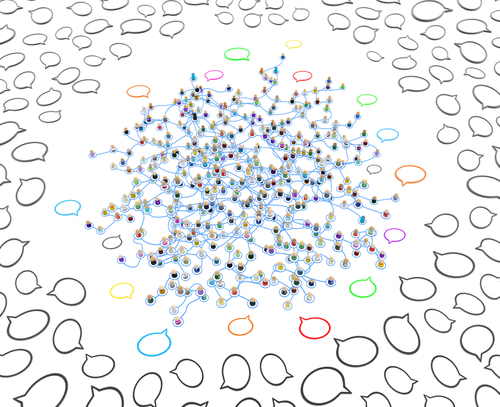
Either way, look at this assignment as an opportunity to learn more about something and to add your voice to the discourse community about said topic. Your professor is assigning you the task to give you a chance to learn more about something and then share that newfound knowledge with the professor and your academic peers. In this way, you contribute meaningfully to the existing scholarship in that subject area. You are then creating a research space for yourself and for other researchers who may follow you.
Mailing Address: 3501 University Blvd. East, Adelphi, MD 20783 This work is licensed under a Creative Commons Attribution-NonCommercial-ShareAlike 4.0 International License . © 2022 UMGC. All links to external sites were verified at the time of publication. UMGC is not responsible for the validity or integrity of information located at external sites.
Table of Contents: Online Guide to Writing
Chapter 1: College Writing
How Does College Writing Differ from Workplace Writing?
What Is College Writing?
Why So Much Emphasis on Writing?
Chapter 2: The Writing Process
Doing Exploratory Research
Getting from Notes to Your Draft
Introduction
Prewriting - Techniques to Get Started - Mining Your Intuition
Prewriting: Targeting Your Audience
Prewriting: Techniques to Get Started
Prewriting: Understanding Your Assignment
Rewriting: Being Your Own Critic
Rewriting: Creating a Revision Strategy
Rewriting: Getting Feedback
Rewriting: The Final Draft
Techniques to Get Started - Outlining
Techniques to Get Started - Using Systematic Techniques
Thesis Statement and Controlling Idea
Writing: Getting from Notes to Your Draft - Freewriting
Writing: Getting from Notes to Your Draft - Summarizing Your Ideas
Writing: Outlining What You Will Write
Chapter 3: Thinking Strategies
A Word About Style, Voice, and Tone
A Word About Style, Voice, and Tone: Style Through Vocabulary and Diction
Critical Strategies and Writing
Critical Strategies and Writing: Analysis
Critical Strategies and Writing: Evaluation
Critical Strategies and Writing: Persuasion
Critical Strategies and Writing: Synthesis
Developing a Paper Using Strategies
Kinds of Assignments You Will Write
Patterns for Presenting Information
Patterns for Presenting Information: Critiques
Patterns for Presenting Information: Discussing Raw Data
Patterns for Presenting Information: General-to-Specific Pattern
Patterns for Presenting Information: Problem-Cause-Solution Pattern
Patterns for Presenting Information: Specific-to-General Pattern
Patterns for Presenting Information: Summaries and Abstracts
Supporting with Research and Examples
Writing Essay Examinations
Writing Essay Examinations: Make Your Answer Relevant and Complete
Writing Essay Examinations: Organize Thinking Before Writing
Writing Essay Examinations: Read and Understand the Question
Chapter 4: The Research Process
Planning and Writing a Research Paper
Planning and Writing a Research Paper: Ask a Research Question
Planning and Writing a Research Paper: Cite Sources
Planning and Writing a Research Paper: Collect Evidence
Planning and Writing a Research Paper: Decide Your Point of View, or Role, for Your Research
Planning and Writing a Research Paper: Draw Conclusions
Planning and Writing a Research Paper: Find a Topic and Get an Overview
Planning and Writing a Research Paper: Manage Your Resources
Planning and Writing a Research Paper: Outline
Planning and Writing a Research Paper: Survey the Literature
Planning and Writing a Research Paper: Work Your Sources into Your Research Writing
Research Resources: Where Are Research Resources Found? - Human Resources
Research Resources: What Are Research Resources?
Research Resources: Where Are Research Resources Found?
Research Resources: Where Are Research Resources Found? - Electronic Resources
Research Resources: Where Are Research Resources Found? - Print Resources
Structuring the Research Paper: Formal Research Structure
Structuring the Research Paper: Informal Research Structure
The Nature of Research
The Research Assignment: How Should Research Sources Be Evaluated?
The Research Assignment: When Is Research Needed?
The Research Assignment: Why Perform Research?
Chapter 5: Academic Integrity
Academic Integrity
Giving Credit to Sources
Giving Credit to Sources: Copyright Laws
Giving Credit to Sources: Documentation
Giving Credit to Sources: Style Guides
Integrating Sources
Practicing Academic Integrity
Practicing Academic Integrity: Keeping Accurate Records
Practicing Academic Integrity: Managing Source Material
Practicing Academic Integrity: Managing Source Material - Paraphrasing Your Source
Practicing Academic Integrity: Managing Source Material - Quoting Your Source
Practicing Academic Integrity: Managing Source Material - Summarizing Your Sources
Types of Documentation
Types of Documentation: Bibliographies and Source Lists
Types of Documentation: Citing World Wide Web Sources
Types of Documentation: In-Text or Parenthetical Citations
Types of Documentation: In-Text or Parenthetical Citations - APA Style
Types of Documentation: In-Text or Parenthetical Citations - CSE/CBE Style
Types of Documentation: In-Text or Parenthetical Citations - Chicago Style
Types of Documentation: In-Text or Parenthetical Citations - MLA Style
Types of Documentation: Note Citations
Chapter 6: Using Library Resources
Finding Library Resources
Chapter 7: Assessing Your Writing
How Is Writing Graded?
How Is Writing Graded?: A General Assessment Tool
The Draft Stage
The Draft Stage: The First Draft
The Draft Stage: The Revision Process and the Final Draft
The Draft Stage: Using Feedback
The Research Stage
Using Assessment to Improve Your Writing
Chapter 8: Other Frequently Assigned Papers
Reviews and Reaction Papers: Article and Book Reviews
Reviews and Reaction Papers: Reaction Papers
Writing Arguments
Writing Arguments: Adapting the Argument Structure
Writing Arguments: Purposes of Argument
Writing Arguments: References to Consult for Writing Arguments
Writing Arguments: Steps to Writing an Argument - Anticipate Active Opposition
Writing Arguments: Steps to Writing an Argument - Determine Your Organization
Writing Arguments: Steps to Writing an Argument - Develop Your Argument
Writing Arguments: Steps to Writing an Argument - Introduce Your Argument
Writing Arguments: Steps to Writing an Argument - State Your Thesis or Proposition
Writing Arguments: Steps to Writing an Argument - Write Your Conclusion
Writing Arguments: Types of Argument
Appendix A: Books to Help Improve Your Writing
Dictionaries
General Style Manuals
Researching on the Internet
Special Style Manuals
Writing Handbooks
Appendix B: Collaborative Writing and Peer Reviewing
Collaborative Writing: Assignments to Accompany the Group Project
Collaborative Writing: Informal Progress Report
Collaborative Writing: Issues to Resolve
Collaborative Writing: Methodology
Collaborative Writing: Peer Evaluation
Collaborative Writing: Tasks of Collaborative Writing Group Members
Collaborative Writing: Writing Plan
General Introduction
Peer Reviewing
Appendix C: Developing an Improvement Plan
Working with Your Instructor’s Comments and Grades
Appendix D: Writing Plan and Project Schedule
Devising a Writing Project Plan and Schedule
Reviewing Your Plan with Others
By using our website you agree to our use of cookies. Learn more about how we use cookies by reading our Privacy Policy .

Understanding Research Assignments
Before you begin researching and writing, you should spend some time understanding your assignment and preparing your process and workflows. To make the most productive use of your time, you'll need to know what you're trying to accomplish and have a consistent process for gathering information, reading, and note-taking.
1) About Research Assignments
2) avoiding plagiarism, 3) organizing your readings, about research assignments.
Most of your courses will require you to complete a research assignment of one kind or another. In general, the goal of a research assignment is to get you to gather information about a certain topic, analyze that information, and report what you’ve learned as part of a class presentation or research paper/essay.
Types of Research Assignments
You can find useful information about the different types of research and writing assignments at the Online Writing Lab .
Important Things to Note About Your Assignment
Relationship to other assignments : Some professors will design their assignments to flow together. You may find that each assignment requires you to do a little bit more work towards writing a big final paper.
Choice of topic : You may be given a list of possible research topics, or you may be asked to choose a topic of interest to you. In either case, it’s a good idea to chat with your prof and do some preliminary research before deciding.
Number and Type of Sources : Often, professors will ask that you use a minimum number of sources in your paper. Information sources can be almost anything, but you may be required to use only, or mostly, academic/peer-reviewed sources.
Citation/Referencing Style : There are many different styles for referencing your sources. The most commonly used styles are APA, MLA, Chicago, and CSE. Make sure you know which you are expected to use, and take a moment to learn the basics of the style.
Length : You will usually be asked to write a paper of specified length. Be sure to start early and give yourself enough time to do the appropriate amount of research and writing.
Library Access
Completing your assignments will require access to the library’s collection. These are specialized resources you won’t find available freely on the Internet. You can access the library’s online collections (databases) through our website. If you are off-campus, you’ll be required to authenticate with your WebAdvisor username and password.
Back to Top
Avoiding Plagiarism
The following definition of plagiarism can be found in the University of Winnipeg Academic Misconduct Policy :
“Plagiarism is a form of academic dishonesty in which students present published or unpublished work (written, digital, or other) of another person or persons, or one’s own prior work, in its entirety or in part, as their own original work.”
Every student is expected to produce work that follows the rules of academic integrity, so avoiding plagiarism is a fundamental skill in university. To be clear, you will generally be expected to use other people’s ideas to support the points in your paper, but the source of every idea that isn’t your own needs to be cited in a suitable format.
There are two ways that plagiarism can happen: intentionally and unintentionally. We’ll talk about each here.
Intentional Plagiarism
With the abundance of information available online, it’s incredibly easy to take credit for something you didn’t write, if that’s your intention. However, simply copying information from a website or blog and pasting it into your paper without crediting the source is considered plagiarism. Add this to the act of getting someone (or paying them) to write your paper for you, which is clearly unethical, and you have an idea of how intentional plagiarism happens.
As easy as it is, though, it’s also very easy to detect. If you plagiarize something, your professor only needs to do a couple of simple Google searches or use a plagiarism detection software to figure it out. Plus, your professors often craft their assignments to see how you develop as a researcher and writer during the course. If you are not producing original work, you won’t be effectively demonstrating your development and your grades may suffer, even if you don’t get caught.
Unintentional Plagiarism
Plagiarism can also happen by accident. This usually results from sloppy note-taking or by writing your paper in a rush. Even if you accidentally use another person’s idea without credit, you are still plagiarizing them. Also, most students don’t realize it’s possible to plagiarize yourself, by using your own published ideas without citation.
Basically, any idea that comes from a source (books, articles, websites, videos, previous papers, etc.) needs to be cited.
There can be serious penalties for plagiarism (again, see the Academic Misconduct Policy ). It isn’t worth it to try, and taking the time to properly cite and reference your sources isn’t too difficult once you get in the habit.
Tips for Avoiding Plagiarism
- Don’t procrastinate.
- Create a reference for all your sources, in the format outlined by your prof.
- Take detailed notes as your read each source, noting the page numbers for each idea.
- Paraphrase major points and indicate if an idea is a direct quote.
- In your paper, properly cite all the ideas from your sources.
- Create a bibliography or works cited, including references for all your sources.
Organizing Your Readings
Writing a research paper can be difficult and frustrating if you don’t keep your sources organized. Here’s some advice to keep your readings, notes, and bibliographies organized so you don’t run into trouble later.
- Create a separate folder on your computer for each research project you’re working on.
- Place all your full-text articles (PDFs) in this folder.
- Create a complete bibliography entry for each of your sources (including books and other non-digital sources) and save the file to this folder.
- As you read your sources, take notes under the bibliography entry. Be sure to note the page numbers as appropriate.
When it comes time to put these ideas together into a first draft of your paper, it will be easy to see which ideas came from which source. This will make writing a lot easier, but also help you to see how your sources agree or disagree on your topic, and make sure you avoid accidentally plagiarizing any of your sources.
Many students and researchers like to use a citation management tool to help keep their sources organized, and to create citations and references. If you're interested in this, you may want to have a look at this information about using Zotero , which is one example of a citation manager.
This website would like to use cookies to enhance your browsing experience. You may change your preferences at any time. Learn more about our use of cookies.
Emergency Alert Notification
Monday, May 14, 2020, at 12:00pm
This is a test of the emergency alert notification pop-up.
Random Assignment in Psychology: Definition & Examples
Julia Simkus
Editor at Simply Psychology
BA (Hons) Psychology, Princeton University
Julia Simkus is a graduate of Princeton University with a Bachelor of Arts in Psychology. She is currently studying for a Master's Degree in Counseling for Mental Health and Wellness in September 2023. Julia's research has been published in peer reviewed journals.
Learn about our Editorial Process
Saul Mcleod, PhD
Editor-in-Chief for Simply Psychology
BSc (Hons) Psychology, MRes, PhD, University of Manchester
Saul Mcleod, PhD., is a qualified psychology teacher with over 18 years of experience in further and higher education. He has been published in peer-reviewed journals, including the Journal of Clinical Psychology.
Olivia Guy-Evans, MSc
Associate Editor for Simply Psychology
BSc (Hons) Psychology, MSc Psychology of Education
Olivia Guy-Evans is a writer and associate editor for Simply Psychology. She has previously worked in healthcare and educational sectors.
In psychology, random assignment refers to the practice of allocating participants to different experimental groups in a study in a completely unbiased way, ensuring each participant has an equal chance of being assigned to any group.
In experimental research, random assignment, or random placement, organizes participants from your sample into different groups using randomization.
Random assignment uses chance procedures to ensure that each participant has an equal opportunity of being assigned to either a control or experimental group.
The control group does not receive the treatment in question, whereas the experimental group does receive the treatment.
When using random assignment, neither the researcher nor the participant can choose the group to which the participant is assigned. This ensures that any differences between and within the groups are not systematic at the onset of the study.
In a study to test the success of a weight-loss program, investigators randomly assigned a pool of participants to one of two groups.
Group A participants participated in the weight-loss program for 10 weeks and took a class where they learned about the benefits of healthy eating and exercise.
Group B participants read a 200-page book that explains the benefits of weight loss. The investigator randomly assigned participants to one of the two groups.
The researchers found that those who participated in the program and took the class were more likely to lose weight than those in the other group that received only the book.
Importance
Random assignment ensures that each group in the experiment is identical before applying the independent variable.
In experiments , researchers will manipulate an independent variable to assess its effect on a dependent variable, while controlling for other variables. Random assignment increases the likelihood that the treatment groups are the same at the onset of a study.
Thus, any changes that result from the independent variable can be assumed to be a result of the treatment of interest. This is particularly important for eliminating sources of bias and strengthening the internal validity of an experiment.
Random assignment is the best method for inferring a causal relationship between a treatment and an outcome.
Random Selection vs. Random Assignment
Random selection (also called probability sampling or random sampling) is a way of randomly selecting members of a population to be included in your study.
On the other hand, random assignment is a way of sorting the sample participants into control and treatment groups.
Random selection ensures that everyone in the population has an equal chance of being selected for the study. Once the pool of participants has been chosen, experimenters use random assignment to assign participants into groups.
Random assignment is only used in between-subjects experimental designs, while random selection can be used in a variety of study designs.
Random Assignment vs Random Sampling
Random sampling refers to selecting participants from a population so that each individual has an equal chance of being chosen. This method enhances the representativeness of the sample.
Random assignment, on the other hand, is used in experimental designs once participants are selected. It involves allocating these participants to different experimental groups or conditions randomly.
This helps ensure that any differences in results across groups are due to manipulating the independent variable, not preexisting differences among participants.
When to Use Random Assignment
Random assignment is used in experiments with a between-groups or independent measures design.
In these research designs, researchers will manipulate an independent variable to assess its effect on a dependent variable, while controlling for other variables.
There is usually a control group and one or more experimental groups. Random assignment helps ensure that the groups are comparable at the onset of the study.
How to Use Random Assignment
There are a variety of ways to assign participants into study groups randomly. Here are a handful of popular methods:
- Random Number Generator : Give each member of the sample a unique number; use a computer program to randomly generate a number from the list for each group.
- Lottery : Give each member of the sample a unique number. Place all numbers in a hat or bucket and draw numbers at random for each group.
- Flipping a Coin : Flip a coin for each participant to decide if they will be in the control group or experimental group (this method can only be used when you have just two groups)
- Roll a Die : For each number on the list, roll a dice to decide which of the groups they will be in. For example, assume that rolling 1, 2, or 3 places them in a control group and rolling 3, 4, 5 lands them in an experimental group.
When is Random Assignment not used?
- When it is not ethically permissible: Randomization is only ethical if the researcher has no evidence that one treatment is superior to the other or that one treatment might have harmful side effects.
- When answering non-causal questions : If the researcher is just interested in predicting the probability of an event, the causal relationship between the variables is not important and observational designs would be more suitable than random assignment.
- When studying the effect of variables that cannot be manipulated: Some risk factors cannot be manipulated and so it would not make any sense to study them in a randomized trial. For example, we cannot randomly assign participants into categories based on age, gender, or genetic factors.
Drawbacks of Random Assignment
While randomization assures an unbiased assignment of participants to groups, it does not guarantee the equality of these groups. There could still be extraneous variables that differ between groups or group differences that arise from chance. Additionally, there is still an element of luck with random assignments.
Thus, researchers can not produce perfectly equal groups for each specific study. Differences between the treatment group and control group might still exist, and the results of a randomized trial may sometimes be wrong, but this is absolutely okay.
Scientific evidence is a long and continuous process, and the groups will tend to be equal in the long run when data is aggregated in a meta-analysis.
Additionally, external validity (i.e., the extent to which the researcher can use the results of the study to generalize to the larger population) is compromised with random assignment.
Random assignment is challenging to implement outside of controlled laboratory conditions and might not represent what would happen in the real world at the population level.
Random assignment can also be more costly than simple observational studies, where an investigator is just observing events without intervening with the population.
Randomization also can be time-consuming and challenging, especially when participants refuse to receive the assigned treatment or do not adhere to recommendations.
What is the difference between random sampling and random assignment?
Random sampling refers to randomly selecting a sample of participants from a population. Random assignment refers to randomly assigning participants to treatment groups from the selected sample.
Does random assignment increase internal validity?
Yes, random assignment ensures that there are no systematic differences between the participants in each group, enhancing the study’s internal validity .
Does random assignment reduce sampling error?
Yes, with random assignment, participants have an equal chance of being assigned to either a control group or an experimental group, resulting in a sample that is, in theory, representative of the population.
Random assignment does not completely eliminate sampling error because a sample only approximates the population from which it is drawn. However, random sampling is a way to minimize sampling errors.
When is random assignment not possible?
Random assignment is not possible when the experimenters cannot control the treatment or independent variable.
For example, if you want to compare how men and women perform on a test, you cannot randomly assign subjects to these groups.
Participants are not randomly assigned to different groups in this study, but instead assigned based on their characteristics.
Does random assignment eliminate confounding variables?
Yes, random assignment eliminates the influence of any confounding variables on the treatment because it distributes them at random among the study groups. Randomization invalidates any relationship between a confounding variable and the treatment.
Why is random assignment of participants to treatment conditions in an experiment used?
Random assignment is used to ensure that all groups are comparable at the start of a study. This allows researchers to conclude that the outcomes of the study can be attributed to the intervention at hand and to rule out alternative explanations for study results.
Further Reading
- Bogomolnaia, A., & Moulin, H. (2001). A new solution to the random assignment problem . Journal of Economic theory , 100 (2), 295-328.
- Krause, M. S., & Howard, K. I. (2003). What random assignment does and does not do . Journal of Clinical Psychology , 59 (7), 751-766.
Related Articles

Research Methodology
Qualitative Data Coding

What Is a Focus Group?

Cross-Cultural Research Methodology In Psychology

What Is Internal Validity In Research?

Research Methodology , Statistics
What Is Face Validity In Research? Importance & How To Measure

Criterion Validity: Definition & Examples
Have a language expert improve your writing
Run a free plagiarism check in 10 minutes, automatically generate references for free.
- Knowledge Base
- Methodology
Research Design | Step-by-Step Guide with Examples
Published on 5 May 2022 by Shona McCombes . Revised on 20 March 2023.
A research design is a strategy for answering your research question using empirical data. Creating a research design means making decisions about:
- Your overall aims and approach
- The type of research design you’ll use
- Your sampling methods or criteria for selecting subjects
- Your data collection methods
- The procedures you’ll follow to collect data
- Your data analysis methods
A well-planned research design helps ensure that your methods match your research aims and that you use the right kind of analysis for your data.
Table of contents
Step 1: consider your aims and approach, step 2: choose a type of research design, step 3: identify your population and sampling method, step 4: choose your data collection methods, step 5: plan your data collection procedures, step 6: decide on your data analysis strategies, frequently asked questions.
- Introduction
Before you can start designing your research, you should already have a clear idea of the research question you want to investigate.
There are many different ways you could go about answering this question. Your research design choices should be driven by your aims and priorities – start by thinking carefully about what you want to achieve.
The first choice you need to make is whether you’ll take a qualitative or quantitative approach.
Qualitative research designs tend to be more flexible and inductive , allowing you to adjust your approach based on what you find throughout the research process.
Quantitative research designs tend to be more fixed and deductive , with variables and hypotheses clearly defined in advance of data collection.
It’s also possible to use a mixed methods design that integrates aspects of both approaches. By combining qualitative and quantitative insights, you can gain a more complete picture of the problem you’re studying and strengthen the credibility of your conclusions.
Practical and ethical considerations when designing research
As well as scientific considerations, you need to think practically when designing your research. If your research involves people or animals, you also need to consider research ethics .
- How much time do you have to collect data and write up the research?
- Will you be able to gain access to the data you need (e.g., by travelling to a specific location or contacting specific people)?
- Do you have the necessary research skills (e.g., statistical analysis or interview techniques)?
- Will you need ethical approval ?
At each stage of the research design process, make sure that your choices are practically feasible.
Prevent plagiarism, run a free check.
Within both qualitative and quantitative approaches, there are several types of research design to choose from. Each type provides a framework for the overall shape of your research.
Types of quantitative research designs
Quantitative designs can be split into four main types. Experimental and quasi-experimental designs allow you to test cause-and-effect relationships, while descriptive and correlational designs allow you to measure variables and describe relationships between them.
With descriptive and correlational designs, you can get a clear picture of characteristics, trends, and relationships as they exist in the real world. However, you can’t draw conclusions about cause and effect (because correlation doesn’t imply causation ).
Experiments are the strongest way to test cause-and-effect relationships without the risk of other variables influencing the results. However, their controlled conditions may not always reflect how things work in the real world. They’re often also more difficult and expensive to implement.
Types of qualitative research designs
Qualitative designs are less strictly defined. This approach is about gaining a rich, detailed understanding of a specific context or phenomenon, and you can often be more creative and flexible in designing your research.
The table below shows some common types of qualitative design. They often have similar approaches in terms of data collection, but focus on different aspects when analysing the data.
Your research design should clearly define who or what your research will focus on, and how you’ll go about choosing your participants or subjects.
In research, a population is the entire group that you want to draw conclusions about, while a sample is the smaller group of individuals you’ll actually collect data from.
Defining the population
A population can be made up of anything you want to study – plants, animals, organisations, texts, countries, etc. In the social sciences, it most often refers to a group of people.
For example, will you focus on people from a specific demographic, region, or background? Are you interested in people with a certain job or medical condition, or users of a particular product?
The more precisely you define your population, the easier it will be to gather a representative sample.
Sampling methods
Even with a narrowly defined population, it’s rarely possible to collect data from every individual. Instead, you’ll collect data from a sample.
To select a sample, there are two main approaches: probability sampling and non-probability sampling . The sampling method you use affects how confidently you can generalise your results to the population as a whole.
Probability sampling is the most statistically valid option, but it’s often difficult to achieve unless you’re dealing with a very small and accessible population.
For practical reasons, many studies use non-probability sampling, but it’s important to be aware of the limitations and carefully consider potential biases. You should always make an effort to gather a sample that’s as representative as possible of the population.
Case selection in qualitative research
In some types of qualitative designs, sampling may not be relevant.
For example, in an ethnography or a case study, your aim is to deeply understand a specific context, not to generalise to a population. Instead of sampling, you may simply aim to collect as much data as possible about the context you are studying.
In these types of design, you still have to carefully consider your choice of case or community. You should have a clear rationale for why this particular case is suitable for answering your research question.
For example, you might choose a case study that reveals an unusual or neglected aspect of your research problem, or you might choose several very similar or very different cases in order to compare them.
Data collection methods are ways of directly measuring variables and gathering information. They allow you to gain first-hand knowledge and original insights into your research problem.
You can choose just one data collection method, or use several methods in the same study.
Survey methods
Surveys allow you to collect data about opinions, behaviours, experiences, and characteristics by asking people directly. There are two main survey methods to choose from: questionnaires and interviews.
Observation methods
Observations allow you to collect data unobtrusively, observing characteristics, behaviours, or social interactions without relying on self-reporting.
Observations may be conducted in real time, taking notes as you observe, or you might make audiovisual recordings for later analysis. They can be qualitative or quantitative.
Other methods of data collection
There are many other ways you might collect data depending on your field and topic.
If you’re not sure which methods will work best for your research design, try reading some papers in your field to see what data collection methods they used.
Secondary data
If you don’t have the time or resources to collect data from the population you’re interested in, you can also choose to use secondary data that other researchers already collected – for example, datasets from government surveys or previous studies on your topic.
With this raw data, you can do your own analysis to answer new research questions that weren’t addressed by the original study.
Using secondary data can expand the scope of your research, as you may be able to access much larger and more varied samples than you could collect yourself.
However, it also means you don’t have any control over which variables to measure or how to measure them, so the conclusions you can draw may be limited.
As well as deciding on your methods, you need to plan exactly how you’ll use these methods to collect data that’s consistent, accurate, and unbiased.
Planning systematic procedures is especially important in quantitative research, where you need to precisely define your variables and ensure your measurements are reliable and valid.
Operationalisation
Some variables, like height or age, are easily measured. But often you’ll be dealing with more abstract concepts, like satisfaction, anxiety, or competence. Operationalisation means turning these fuzzy ideas into measurable indicators.
If you’re using observations , which events or actions will you count?
If you’re using surveys , which questions will you ask and what range of responses will be offered?
You may also choose to use or adapt existing materials designed to measure the concept you’re interested in – for example, questionnaires or inventories whose reliability and validity has already been established.
Reliability and validity
Reliability means your results can be consistently reproduced , while validity means that you’re actually measuring the concept you’re interested in.
For valid and reliable results, your measurement materials should be thoroughly researched and carefully designed. Plan your procedures to make sure you carry out the same steps in the same way for each participant.
If you’re developing a new questionnaire or other instrument to measure a specific concept, running a pilot study allows you to check its validity and reliability in advance.
Sampling procedures
As well as choosing an appropriate sampling method, you need a concrete plan for how you’ll actually contact and recruit your selected sample.
That means making decisions about things like:
- How many participants do you need for an adequate sample size?
- What inclusion and exclusion criteria will you use to identify eligible participants?
- How will you contact your sample – by mail, online, by phone, or in person?
If you’re using a probability sampling method, it’s important that everyone who is randomly selected actually participates in the study. How will you ensure a high response rate?
If you’re using a non-probability method, how will you avoid bias and ensure a representative sample?
Data management
It’s also important to create a data management plan for organising and storing your data.
Will you need to transcribe interviews or perform data entry for observations? You should anonymise and safeguard any sensitive data, and make sure it’s backed up regularly.
Keeping your data well organised will save time when it comes to analysing them. It can also help other researchers validate and add to your findings.
On their own, raw data can’t answer your research question. The last step of designing your research is planning how you’ll analyse the data.
Quantitative data analysis
In quantitative research, you’ll most likely use some form of statistical analysis . With statistics, you can summarise your sample data, make estimates, and test hypotheses.
Using descriptive statistics , you can summarise your sample data in terms of:
- The distribution of the data (e.g., the frequency of each score on a test)
- The central tendency of the data (e.g., the mean to describe the average score)
- The variability of the data (e.g., the standard deviation to describe how spread out the scores are)
The specific calculations you can do depend on the level of measurement of your variables.
Using inferential statistics , you can:
- Make estimates about the population based on your sample data.
- Test hypotheses about a relationship between variables.
Regression and correlation tests look for associations between two or more variables, while comparison tests (such as t tests and ANOVAs ) look for differences in the outcomes of different groups.
Your choice of statistical test depends on various aspects of your research design, including the types of variables you’re dealing with and the distribution of your data.
Qualitative data analysis
In qualitative research, your data will usually be very dense with information and ideas. Instead of summing it up in numbers, you’ll need to comb through the data in detail, interpret its meanings, identify patterns, and extract the parts that are most relevant to your research question.
Two of the most common approaches to doing this are thematic analysis and discourse analysis .
There are many other ways of analysing qualitative data depending on the aims of your research. To get a sense of potential approaches, try reading some qualitative research papers in your field.
A sample is a subset of individuals from a larger population. Sampling means selecting the group that you will actually collect data from in your research.
For example, if you are researching the opinions of students in your university, you could survey a sample of 100 students.
Statistical sampling allows you to test a hypothesis about the characteristics of a population. There are various sampling methods you can use to ensure that your sample is representative of the population as a whole.
Operationalisation means turning abstract conceptual ideas into measurable observations.
For example, the concept of social anxiety isn’t directly observable, but it can be operationally defined in terms of self-rating scores, behavioural avoidance of crowded places, or physical anxiety symptoms in social situations.
Before collecting data , it’s important to consider how you will operationalise the variables that you want to measure.
The research methods you use depend on the type of data you need to answer your research question .
- If you want to measure something or test a hypothesis , use quantitative methods . If you want to explore ideas, thoughts, and meanings, use qualitative methods .
- If you want to analyse a large amount of readily available data, use secondary data. If you want data specific to your purposes with control over how they are generated, collect primary data.
- If you want to establish cause-and-effect relationships between variables , use experimental methods. If you want to understand the characteristics of a research subject, use descriptive methods.
Cite this Scribbr article
If you want to cite this source, you can copy and paste the citation or click the ‘Cite this Scribbr article’ button to automatically add the citation to our free Reference Generator.
McCombes, S. (2023, March 20). Research Design | Step-by-Step Guide with Examples. Scribbr. Retrieved 3 June 2024, from https://www.scribbr.co.uk/research-methods/research-design/
Is this article helpful?
Shona McCombes

Research Design 101
Everything You Need To Get Started (With Examples)
By: Derek Jansen (MBA) | Reviewers: Eunice Rautenbach (DTech) & Kerryn Warren (PhD) | April 2023

Navigating the world of research can be daunting, especially if you’re a first-time researcher. One concept you’re bound to run into fairly early in your research journey is that of “ research design ”. Here, we’ll guide you through the basics using practical examples , so that you can approach your research with confidence.
Overview: Research Design 101
What is research design.
- Research design types for quantitative studies
- Video explainer : quantitative research design
- Research design types for qualitative studies
- Video explainer : qualitative research design
- How to choose a research design
- Key takeaways
Research design refers to the overall plan, structure or strategy that guides a research project , from its conception to the final data analysis. A good research design serves as the blueprint for how you, as the researcher, will collect and analyse data while ensuring consistency, reliability and validity throughout your study.
Understanding different types of research designs is essential as helps ensure that your approach is suitable given your research aims, objectives and questions , as well as the resources you have available to you. Without a clear big-picture view of how you’ll design your research, you run the risk of potentially making misaligned choices in terms of your methodology – especially your sampling , data collection and data analysis decisions.
The problem with defining research design…
One of the reasons students struggle with a clear definition of research design is because the term is used very loosely across the internet, and even within academia.
Some sources claim that the three research design types are qualitative, quantitative and mixed methods , which isn’t quite accurate (these just refer to the type of data that you’ll collect and analyse). Other sources state that research design refers to the sum of all your design choices, suggesting it’s more like a research methodology . Others run off on other less common tangents. No wonder there’s confusion!
In this article, we’ll clear up the confusion. We’ll explain the most common research design types for both qualitative and quantitative research projects, whether that is for a full dissertation or thesis, or a smaller research paper or article.

Research Design: Quantitative Studies
Quantitative research involves collecting and analysing data in a numerical form. Broadly speaking, there are four types of quantitative research designs: descriptive , correlational , experimental , and quasi-experimental .
Descriptive Research Design
As the name suggests, descriptive research design focuses on describing existing conditions, behaviours, or characteristics by systematically gathering information without manipulating any variables. In other words, there is no intervention on the researcher’s part – only data collection.
For example, if you’re studying smartphone addiction among adolescents in your community, you could deploy a survey to a sample of teens asking them to rate their agreement with certain statements that relate to smartphone addiction. The collected data would then provide insight regarding how widespread the issue may be – in other words, it would describe the situation.
The key defining attribute of this type of research design is that it purely describes the situation . In other words, descriptive research design does not explore potential relationships between different variables or the causes that may underlie those relationships. Therefore, descriptive research is useful for generating insight into a research problem by describing its characteristics . By doing so, it can provide valuable insights and is often used as a precursor to other research design types.
Correlational Research Design
Correlational design is a popular choice for researchers aiming to identify and measure the relationship between two or more variables without manipulating them . In other words, this type of research design is useful when you want to know whether a change in one thing tends to be accompanied by a change in another thing.
For example, if you wanted to explore the relationship between exercise frequency and overall health, you could use a correlational design to help you achieve this. In this case, you might gather data on participants’ exercise habits, as well as records of their health indicators like blood pressure, heart rate, or body mass index. Thereafter, you’d use a statistical test to assess whether there’s a relationship between the two variables (exercise frequency and health).
As you can see, correlational research design is useful when you want to explore potential relationships between variables that cannot be manipulated or controlled for ethical, practical, or logistical reasons. It is particularly helpful in terms of developing predictions , and given that it doesn’t involve the manipulation of variables, it can be implemented at a large scale more easily than experimental designs (which will look at next).
That said, it’s important to keep in mind that correlational research design has limitations – most notably that it cannot be used to establish causality . In other words, correlation does not equal causation . To establish causality, you’ll need to move into the realm of experimental design, coming up next…
Need a helping hand?
Experimental Research Design
Experimental research design is used to determine if there is a causal relationship between two or more variables . With this type of research design, you, as the researcher, manipulate one variable (the independent variable) while controlling others (dependent variables). Doing so allows you to observe the effect of the former on the latter and draw conclusions about potential causality.
For example, if you wanted to measure if/how different types of fertiliser affect plant growth, you could set up several groups of plants, with each group receiving a different type of fertiliser, as well as one with no fertiliser at all. You could then measure how much each plant group grew (on average) over time and compare the results from the different groups to see which fertiliser was most effective.
Overall, experimental research design provides researchers with a powerful way to identify and measure causal relationships (and the direction of causality) between variables. However, developing a rigorous experimental design can be challenging as it’s not always easy to control all the variables in a study. This often results in smaller sample sizes , which can reduce the statistical power and generalisability of the results.
Moreover, experimental research design requires random assignment . This means that the researcher needs to assign participants to different groups or conditions in a way that each participant has an equal chance of being assigned to any group (note that this is not the same as random sampling ). Doing so helps reduce the potential for bias and confounding variables . This need for random assignment can lead to ethics-related issues . For example, withholding a potentially beneficial medical treatment from a control group may be considered unethical in certain situations.
Quasi-Experimental Research Design
Quasi-experimental research design is used when the research aims involve identifying causal relations , but one cannot (or doesn’t want to) randomly assign participants to different groups (for practical or ethical reasons). Instead, with a quasi-experimental research design, the researcher relies on existing groups or pre-existing conditions to form groups for comparison.
For example, if you were studying the effects of a new teaching method on student achievement in a particular school district, you may be unable to randomly assign students to either group and instead have to choose classes or schools that already use different teaching methods. This way, you still achieve separate groups, without having to assign participants to specific groups yourself.
Naturally, quasi-experimental research designs have limitations when compared to experimental designs. Given that participant assignment is not random, it’s more difficult to confidently establish causality between variables, and, as a researcher, you have less control over other variables that may impact findings.
All that said, quasi-experimental designs can still be valuable in research contexts where random assignment is not possible and can often be undertaken on a much larger scale than experimental research, thus increasing the statistical power of the results. What’s important is that you, as the researcher, understand the limitations of the design and conduct your quasi-experiment as rigorously as possible, paying careful attention to any potential confounding variables .

Research Design: Qualitative Studies
There are many different research design types when it comes to qualitative studies, but here we’ll narrow our focus to explore the “Big 4”. Specifically, we’ll look at phenomenological design, grounded theory design, ethnographic design, and case study design.
Phenomenological Research Design
Phenomenological design involves exploring the meaning of lived experiences and how they are perceived by individuals. This type of research design seeks to understand people’s perspectives , emotions, and behaviours in specific situations. Here, the aim for researchers is to uncover the essence of human experience without making any assumptions or imposing preconceived ideas on their subjects.
For example, you could adopt a phenomenological design to study why cancer survivors have such varied perceptions of their lives after overcoming their disease. This could be achieved by interviewing survivors and then analysing the data using a qualitative analysis method such as thematic analysis to identify commonalities and differences.
Phenomenological research design typically involves in-depth interviews or open-ended questionnaires to collect rich, detailed data about participants’ subjective experiences. This richness is one of the key strengths of phenomenological research design but, naturally, it also has limitations. These include potential biases in data collection and interpretation and the lack of generalisability of findings to broader populations.
Grounded Theory Research Design
Grounded theory (also referred to as “GT”) aims to develop theories by continuously and iteratively analysing and comparing data collected from a relatively large number of participants in a study. It takes an inductive (bottom-up) approach, with a focus on letting the data “speak for itself”, without being influenced by preexisting theories or the researcher’s preconceptions.
As an example, let’s assume your research aims involved understanding how people cope with chronic pain from a specific medical condition, with a view to developing a theory around this. In this case, grounded theory design would allow you to explore this concept thoroughly without preconceptions about what coping mechanisms might exist. You may find that some patients prefer cognitive-behavioural therapy (CBT) while others prefer to rely on herbal remedies. Based on multiple, iterative rounds of analysis, you could then develop a theory in this regard, derived directly from the data (as opposed to other preexisting theories and models).
Grounded theory typically involves collecting data through interviews or observations and then analysing it to identify patterns and themes that emerge from the data. These emerging ideas are then validated by collecting more data until a saturation point is reached (i.e., no new information can be squeezed from the data). From that base, a theory can then be developed .
As you can see, grounded theory is ideally suited to studies where the research aims involve theory generation , especially in under-researched areas. Keep in mind though that this type of research design can be quite time-intensive , given the need for multiple rounds of data collection and analysis.

Ethnographic Research Design
Ethnographic design involves observing and studying a culture-sharing group of people in their natural setting to gain insight into their behaviours, beliefs, and values. The focus here is on observing participants in their natural environment (as opposed to a controlled environment). This typically involves the researcher spending an extended period of time with the participants in their environment, carefully observing and taking field notes .
All of this is not to say that ethnographic research design relies purely on observation. On the contrary, this design typically also involves in-depth interviews to explore participants’ views, beliefs, etc. However, unobtrusive observation is a core component of the ethnographic approach.
As an example, an ethnographer may study how different communities celebrate traditional festivals or how individuals from different generations interact with technology differently. This may involve a lengthy period of observation, combined with in-depth interviews to further explore specific areas of interest that emerge as a result of the observations that the researcher has made.
As you can probably imagine, ethnographic research design has the ability to provide rich, contextually embedded insights into the socio-cultural dynamics of human behaviour within a natural, uncontrived setting. Naturally, however, it does come with its own set of challenges, including researcher bias (since the researcher can become quite immersed in the group), participant confidentiality and, predictably, ethical complexities . All of these need to be carefully managed if you choose to adopt this type of research design.
Case Study Design
With case study research design, you, as the researcher, investigate a single individual (or a single group of individuals) to gain an in-depth understanding of their experiences, behaviours or outcomes. Unlike other research designs that are aimed at larger sample sizes, case studies offer a deep dive into the specific circumstances surrounding a person, group of people, event or phenomenon, generally within a bounded setting or context .
As an example, a case study design could be used to explore the factors influencing the success of a specific small business. This would involve diving deeply into the organisation to explore and understand what makes it tick – from marketing to HR to finance. In terms of data collection, this could include interviews with staff and management, review of policy documents and financial statements, surveying customers, etc.
While the above example is focused squarely on one organisation, it’s worth noting that case study research designs can have different variation s, including single-case, multiple-case and longitudinal designs. As you can see in the example, a single-case design involves intensely examining a single entity to understand its unique characteristics and complexities. Conversely, in a multiple-case design , multiple cases are compared and contrasted to identify patterns and commonalities. Lastly, in a longitudinal case design , a single case or multiple cases are studied over an extended period of time to understand how factors develop over time.
As you can see, a case study research design is particularly useful where a deep and contextualised understanding of a specific phenomenon or issue is desired. However, this strength is also its weakness. In other words, you can’t generalise the findings from a case study to the broader population. So, keep this in mind if you’re considering going the case study route.

How To Choose A Research Design
Having worked through all of these potential research designs, you’d be forgiven for feeling a little overwhelmed and wondering, “ But how do I decide which research design to use? ”. While we could write an entire post covering that alone, here are a few factors to consider that will help you choose a suitable research design for your study.
Data type: The first determining factor is naturally the type of data you plan to be collecting – i.e., qualitative or quantitative. This may sound obvious, but we have to be clear about this – don’t try to use a quantitative research design on qualitative data (or vice versa)!
Research aim(s) and question(s): As with all methodological decisions, your research aim and research questions will heavily influence your research design. For example, if your research aims involve developing a theory from qualitative data, grounded theory would be a strong option. Similarly, if your research aims involve identifying and measuring relationships between variables, one of the experimental designs would likely be a better option.
Time: It’s essential that you consider any time constraints you have, as this will impact the type of research design you can choose. For example, if you’ve only got a month to complete your project, a lengthy design such as ethnography wouldn’t be a good fit.
Resources: Take into account the resources realistically available to you, as these need to factor into your research design choice. For example, if you require highly specialised lab equipment to execute an experimental design, you need to be sure that you’ll have access to that before you make a decision.
Keep in mind that when it comes to research, it’s important to manage your risks and play as conservatively as possible. If your entire project relies on you achieving a huge sample, having access to niche equipment or holding interviews with very difficult-to-reach participants, you’re creating risks that could kill your project. So, be sure to think through your choices carefully and make sure that you have backup plans for any existential risks. Remember that a relatively simple methodology executed well generally will typically earn better marks than a highly-complex methodology executed poorly.

Recap: Key Takeaways
We’ve covered a lot of ground here. Let’s recap by looking at the key takeaways:
- Research design refers to the overall plan, structure or strategy that guides a research project, from its conception to the final analysis of data.
- Research designs for quantitative studies include descriptive , correlational , experimental and quasi-experimenta l designs.
- Research designs for qualitative studies include phenomenological , grounded theory , ethnographic and case study designs.
- When choosing a research design, you need to consider a variety of factors, including the type of data you’ll be working with, your research aims and questions, your time and the resources available to you.
If you need a helping hand with your research design (or any other aspect of your research), check out our private coaching services .

Psst... there’s more!
This post was based on one of our popular Research Bootcamps . If you're working on a research project, you'll definitely want to check this out ...
You Might Also Like:

10 Comments
Is there any blog article explaining more on Case study research design? Is there a Case study write-up template? Thank you.
Thanks this was quite valuable to clarify such an important concept.
Thanks for this simplified explanations. it is quite very helpful.
This was really helpful. thanks
Thank you for your explanation. I think case study research design and the use of secondary data in researches needs to be talked about more in your videos and articles because there a lot of case studies research design tailored projects out there.
Please is there any template for a case study research design whose data type is a secondary data on your repository?
This post is very clear, comprehensive and has been very helpful to me. It has cleared the confusion I had in regard to research design and methodology.
This post is helpful, easy to understand, and deconstructs what a research design is. Thanks
how to cite this page
Thank you very much for the post. It is wonderful and has cleared many worries in my mind regarding research designs. I really appreciate .
how can I put this blog as my reference(APA style) in bibliography part?
Submit a Comment Cancel reply
Your email address will not be published. Required fields are marked *
Save my name, email, and website in this browser for the next time I comment.
- Print Friendly

Understanding Assignments
What this handout is about.
The first step in any successful college writing venture is reading the assignment. While this sounds like a simple task, it can be a tough one. This handout will help you unravel your assignment and begin to craft an effective response. Much of the following advice will involve translating typical assignment terms and practices into meaningful clues to the type of writing your instructor expects. See our short video for more tips.
Basic beginnings
Regardless of the assignment, department, or instructor, adopting these two habits will serve you well :
- Read the assignment carefully as soon as you receive it. Do not put this task off—reading the assignment at the beginning will save you time, stress, and problems later. An assignment can look pretty straightforward at first, particularly if the instructor has provided lots of information. That does not mean it will not take time and effort to complete; you may even have to learn a new skill to complete the assignment.
- Ask the instructor about anything you do not understand. Do not hesitate to approach your instructor. Instructors would prefer to set you straight before you hand the paper in. That’s also when you will find their feedback most useful.
Assignment formats
Many assignments follow a basic format. Assignments often begin with an overview of the topic, include a central verb or verbs that describe the task, and offer some additional suggestions, questions, or prompts to get you started.
An Overview of Some Kind
The instructor might set the stage with some general discussion of the subject of the assignment, introduce the topic, or remind you of something pertinent that you have discussed in class. For example:
“Throughout history, gerbils have played a key role in politics,” or “In the last few weeks of class, we have focused on the evening wear of the housefly …”
The Task of the Assignment
Pay attention; this part tells you what to do when you write the paper. Look for the key verb or verbs in the sentence. Words like analyze, summarize, or compare direct you to think about your topic in a certain way. Also pay attention to words such as how, what, when, where, and why; these words guide your attention toward specific information. (See the section in this handout titled “Key Terms” for more information.)
“Analyze the effect that gerbils had on the Russian Revolution”, or “Suggest an interpretation of housefly undergarments that differs from Darwin’s.”
Additional Material to Think about
Here you will find some questions to use as springboards as you begin to think about the topic. Instructors usually include these questions as suggestions rather than requirements. Do not feel compelled to answer every question unless the instructor asks you to do so. Pay attention to the order of the questions. Sometimes they suggest the thinking process your instructor imagines you will need to follow to begin thinking about the topic.
“You may wish to consider the differing views held by Communist gerbils vs. Monarchist gerbils, or Can there be such a thing as ‘the housefly garment industry’ or is it just a home-based craft?”
These are the instructor’s comments about writing expectations:
“Be concise”, “Write effectively”, or “Argue furiously.”
Technical Details
These instructions usually indicate format rules or guidelines.
“Your paper must be typed in Palatino font on gray paper and must not exceed 600 pages. It is due on the anniversary of Mao Tse-tung’s death.”
The assignment’s parts may not appear in exactly this order, and each part may be very long or really short. Nonetheless, being aware of this standard pattern can help you understand what your instructor wants you to do.
Interpreting the assignment
Ask yourself a few basic questions as you read and jot down the answers on the assignment sheet:
Why did your instructor ask you to do this particular task?
Who is your audience.
- What kind of evidence do you need to support your ideas?
What kind of writing style is acceptable?
- What are the absolute rules of the paper?
Try to look at the question from the point of view of the instructor. Recognize that your instructor has a reason for giving you this assignment and for giving it to you at a particular point in the semester. In every assignment, the instructor has a challenge for you. This challenge could be anything from demonstrating an ability to think clearly to demonstrating an ability to use the library. See the assignment not as a vague suggestion of what to do but as an opportunity to show that you can handle the course material as directed. Paper assignments give you more than a topic to discuss—they ask you to do something with the topic. Keep reminding yourself of that. Be careful to avoid the other extreme as well: do not read more into the assignment than what is there.
Of course, your instructor has given you an assignment so that they will be able to assess your understanding of the course material and give you an appropriate grade. But there is more to it than that. Your instructor has tried to design a learning experience of some kind. Your instructor wants you to think about something in a particular way for a particular reason. If you read the course description at the beginning of your syllabus, review the assigned readings, and consider the assignment itself, you may begin to see the plan, purpose, or approach to the subject matter that your instructor has created for you. If you still aren’t sure of the assignment’s goals, try asking the instructor. For help with this, see our handout on getting feedback .
Given your instructor’s efforts, it helps to answer the question: What is my purpose in completing this assignment? Is it to gather research from a variety of outside sources and present a coherent picture? Is it to take material I have been learning in class and apply it to a new situation? Is it to prove a point one way or another? Key words from the assignment can help you figure this out. Look for key terms in the form of active verbs that tell you what to do.
Key Terms: Finding Those Active Verbs
Here are some common key words and definitions to help you think about assignment terms:
Information words Ask you to demonstrate what you know about the subject, such as who, what, when, where, how, and why.
- define —give the subject’s meaning (according to someone or something). Sometimes you have to give more than one view on the subject’s meaning
- describe —provide details about the subject by answering question words (such as who, what, when, where, how, and why); you might also give details related to the five senses (what you see, hear, feel, taste, and smell)
- explain —give reasons why or examples of how something happened
- illustrate —give descriptive examples of the subject and show how each is connected with the subject
- summarize —briefly list the important ideas you learned about the subject
- trace —outline how something has changed or developed from an earlier time to its current form
- research —gather material from outside sources about the subject, often with the implication or requirement that you will analyze what you have found
Relation words Ask you to demonstrate how things are connected.
- compare —show how two or more things are similar (and, sometimes, different)
- contrast —show how two or more things are dissimilar
- apply—use details that you’ve been given to demonstrate how an idea, theory, or concept works in a particular situation
- cause —show how one event or series of events made something else happen
- relate —show or describe the connections between things
Interpretation words Ask you to defend ideas of your own about the subject. Do not see these words as requesting opinion alone (unless the assignment specifically says so), but as requiring opinion that is supported by concrete evidence. Remember examples, principles, definitions, or concepts from class or research and use them in your interpretation.
- assess —summarize your opinion of the subject and measure it against something
- prove, justify —give reasons or examples to demonstrate how or why something is the truth
- evaluate, respond —state your opinion of the subject as good, bad, or some combination of the two, with examples and reasons
- support —give reasons or evidence for something you believe (be sure to state clearly what it is that you believe)
- synthesize —put two or more things together that have not been put together in class or in your readings before; do not just summarize one and then the other and say that they are similar or different—you must provide a reason for putting them together that runs all the way through the paper
- analyze —determine how individual parts create or relate to the whole, figure out how something works, what it might mean, or why it is important
- argue —take a side and defend it with evidence against the other side
More Clues to Your Purpose As you read the assignment, think about what the teacher does in class:
- What kinds of textbooks or coursepack did your instructor choose for the course—ones that provide background information, explain theories or perspectives, or argue a point of view?
- In lecture, does your instructor ask your opinion, try to prove their point of view, or use keywords that show up again in the assignment?
- What kinds of assignments are typical in this discipline? Social science classes often expect more research. Humanities classes thrive on interpretation and analysis.
- How do the assignments, readings, and lectures work together in the course? Instructors spend time designing courses, sometimes even arguing with their peers about the most effective course materials. Figuring out the overall design to the course will help you understand what each assignment is meant to achieve.
Now, what about your reader? Most undergraduates think of their audience as the instructor. True, your instructor is a good person to keep in mind as you write. But for the purposes of a good paper, think of your audience as someone like your roommate: smart enough to understand a clear, logical argument, but not someone who already knows exactly what is going on in your particular paper. Remember, even if the instructor knows everything there is to know about your paper topic, they still have to read your paper and assess your understanding. In other words, teach the material to your reader.
Aiming a paper at your audience happens in two ways: you make decisions about the tone and the level of information you want to convey.
- Tone means the “voice” of your paper. Should you be chatty, formal, or objective? Usually you will find some happy medium—you do not want to alienate your reader by sounding condescending or superior, but you do not want to, um, like, totally wig on the man, you know? Eschew ostentatious erudition: some students think the way to sound academic is to use big words. Be careful—you can sound ridiculous, especially if you use the wrong big words.
- The level of information you use depends on who you think your audience is. If you imagine your audience as your instructor and they already know everything you have to say, you may find yourself leaving out key information that can cause your argument to be unconvincing and illogical. But you do not have to explain every single word or issue. If you are telling your roommate what happened on your favorite science fiction TV show last night, you do not say, “First a dark-haired white man of average height, wearing a suit and carrying a flashlight, walked into the room. Then a purple alien with fifteen arms and at least three eyes turned around. Then the man smiled slightly. In the background, you could hear a clock ticking. The room was fairly dark and had at least two windows that I saw.” You also do not say, “This guy found some aliens. The end.” Find some balance of useful details that support your main point.
You’ll find a much more detailed discussion of these concepts in our handout on audience .
The Grim Truth
With a few exceptions (including some lab and ethnography reports), you are probably being asked to make an argument. You must convince your audience. It is easy to forget this aim when you are researching and writing; as you become involved in your subject matter, you may become enmeshed in the details and focus on learning or simply telling the information you have found. You need to do more than just repeat what you have read. Your writing should have a point, and you should be able to say it in a sentence. Sometimes instructors call this sentence a “thesis” or a “claim.”
So, if your instructor tells you to write about some aspect of oral hygiene, you do not want to just list: “First, you brush your teeth with a soft brush and some peanut butter. Then, you floss with unwaxed, bologna-flavored string. Finally, gargle with bourbon.” Instead, you could say, “Of all the oral cleaning methods, sandblasting removes the most plaque. Therefore it should be recommended by the American Dental Association.” Or, “From an aesthetic perspective, moldy teeth can be quite charming. However, their joys are short-lived.”
Convincing the reader of your argument is the goal of academic writing. It doesn’t have to say “argument” anywhere in the assignment for you to need one. Look at the assignment and think about what kind of argument you could make about it instead of just seeing it as a checklist of information you have to present. For help with understanding the role of argument in academic writing, see our handout on argument .
What kind of evidence do you need?
There are many kinds of evidence, and what type of evidence will work for your assignment can depend on several factors–the discipline, the parameters of the assignment, and your instructor’s preference. Should you use statistics? Historical examples? Do you need to conduct your own experiment? Can you rely on personal experience? See our handout on evidence for suggestions on how to use evidence appropriately.
Make sure you are clear about this part of the assignment, because your use of evidence will be crucial in writing a successful paper. You are not just learning how to argue; you are learning how to argue with specific types of materials and ideas. Ask your instructor what counts as acceptable evidence. You can also ask a librarian for help. No matter what kind of evidence you use, be sure to cite it correctly—see the UNC Libraries citation tutorial .
You cannot always tell from the assignment just what sort of writing style your instructor expects. The instructor may be really laid back in class but still expect you to sound formal in writing. Or the instructor may be fairly formal in class and ask you to write a reflection paper where you need to use “I” and speak from your own experience.
Try to avoid false associations of a particular field with a style (“art historians like wacky creativity,” or “political scientists are boring and just give facts”) and look instead to the types of readings you have been given in class. No one expects you to write like Plato—just use the readings as a guide for what is standard or preferable to your instructor. When in doubt, ask your instructor about the level of formality they expect.
No matter what field you are writing for or what facts you are including, if you do not write so that your reader can understand your main idea, you have wasted your time. So make clarity your main goal. For specific help with style, see our handout on style .
Technical details about the assignment
The technical information you are given in an assignment always seems like the easy part. This section can actually give you lots of little hints about approaching the task. Find out if elements such as page length and citation format (see the UNC Libraries citation tutorial ) are negotiable. Some professors do not have strong preferences as long as you are consistent and fully answer the assignment. Some professors are very specific and will deduct big points for deviations.
Usually, the page length tells you something important: The instructor thinks the size of the paper is appropriate to the assignment’s parameters. In plain English, your instructor is telling you how many pages it should take for you to answer the question as fully as you are expected to. So if an assignment is two pages long, you cannot pad your paper with examples or reword your main idea several times. Hit your one point early, defend it with the clearest example, and finish quickly. If an assignment is ten pages long, you can be more complex in your main points and examples—and if you can only produce five pages for that assignment, you need to see someone for help—as soon as possible.
Tricks that don’t work
Your instructors are not fooled when you:
- spend more time on the cover page than the essay —graphics, cool binders, and cute titles are no replacement for a well-written paper.
- use huge fonts, wide margins, or extra spacing to pad the page length —these tricks are immediately obvious to the eye. Most instructors use the same word processor you do. They know what’s possible. Such tactics are especially damning when the instructor has a stack of 60 papers to grade and yours is the only one that low-flying airplane pilots could read.
- use a paper from another class that covered “sort of similar” material . Again, the instructor has a particular task for you to fulfill in the assignment that usually relates to course material and lectures. Your other paper may not cover this material, and turning in the same paper for more than one course may constitute an Honor Code violation . Ask the instructor—it can’t hurt.
- get all wacky and “creative” before you answer the question . Showing that you are able to think beyond the boundaries of a simple assignment can be good, but you must do what the assignment calls for first. Again, check with your instructor. A humorous tone can be refreshing for someone grading a stack of papers, but it will not get you a good grade if you have not fulfilled the task.
Critical reading of assignments leads to skills in other types of reading and writing. If you get good at figuring out what the real goals of assignments are, you are going to be better at understanding the goals of all of your classes and fields of study.
You may reproduce it for non-commercial use if you use the entire handout and attribute the source: The Writing Center, University of North Carolina at Chapel Hill
Make a Gift

- Policy & Compliance
- Changes Coming To NIH Applications and Peer Review In 2025
Changes Coming to NIH Applications and Peer Review in 2025
This page serves as a central location where you can learn more about multiple changes coming in 2025 that will affect the submission and review of NIH grant applications.
These changes include updates to the peer review and submission of most research project grants, fellowships, and training grants; Common Forms for NIH biographical sketch and Current and Pending (Other) Support; updated instructions for reference letters; and the transition to FORMS-I application instructions. Although each of these initiatives has specific goals, they are all meant to simplify, clarify, and/or promote greater fairness towards a level playing field for applicants throughout the application and review processes.
Upcoming Webinars
Learn more and have the opportunity to ask questions at the following upcoming webinars:
- June 5, 2024 : Webinar on Updates to NIH Training Grant Applications (registration open)
- September 19, 2024 : Webinar on Revisions to the Fellowship Application and Review Process (registration open)

Simplified Review Framework for Most Research Project Grants (RPGs)
NIH is implementing a simplified framework for the peer review of the majority of competing research project grant (RPG) applications, beginning with submissions with due dates on or after January 25, 2025.

Revisions to the NIH Fellowship Application and Review Process
NIH is revising the fellowship review criteria used to evaluate fellowship applications and modifying the PHS Fellowship Supplemental Form to align with the restructured review criteria beginning with submissions with due dates on or after January 25, 2025.

Updates to Training Grant Applications
The NIH Training Program applications are undergoing changes that take effect for submissions with due dates on or after January 25, 2025.
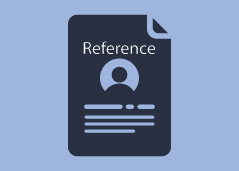
Updates to Reference Letter Instructions for Referees
NIH is updating the instructions for reference letters submitted for due dates on or after January 25, 2025 to provide more structure so letters will better assist reviewers in understanding the candidate’s strengths, weaknesses, and potential to pursue a productive career in biomedical science. Updated instructions will be posted on the NIH Grants page for Reference Letters as soon as they are available (later in 2024).

Updated Application Forms and Instructions (FORMS-I)
NIH is updating application forms to support many of the changes coming in 2025. These new forms will provide the needed form fields to efficiently implement policy updates and align form instructions and field labels with current terminology. Updated application forms will be posted with active funding opportunities in the Fall of 2024, and updated instructions will be available on the How to Apply - Application Guide at that time.

Common Forms for Biographical Sketch and Current and Pending (Other) Support
NIH is adopting the Biographical Sketch Common Form and the Current and Pending (Other) Support Common Form in 2025. Information on the timing and details of implementation are expected in the coming months.

NIH will provide applicants with plenty of training and resources throughout 2024. The below resources discuss the collective changes coming in January 2025. Additional resources for each initiative can be found on their respective pages.
- Overview of Grant Application and Review Changes for Due Dates on or after January 25, 2025: NOT-OD-24-084
- Drop-in slides on changes coming in 2025 (PowerPoint)
This page last updated on: May 17, 2024
- Bookmark & Share
- E-mail Updates
- Help Downloading Files
- Privacy Notice
- Accessibility
- National Institutes of Health (NIH), 9000 Rockville Pike, Bethesda, Maryland 20892
- NIH... Turning Discovery Into Health
Food is Medicine: A Project to Unify and Advance Collective Action

The White House Conference on Hunger, Nutrition, and Health — held in September 2022 — renewed national attention and issued a call to action to end hunger and reduce the prevalence of chronic disease in the United States by 2030.
Food is Medicine approaches that focus on integrating consistent access to diet- and nutrition- related resources are a critical component to achieve this goal. The approaches are increasingly present across many communities and systems. There’s also increasing federal investment and action to support Food is Medicine approaches in a variety of settings.
Building on this collective energy, the Department of Health and Human Services (HHS) developed a Food is Medicine initiative in response to a congressionally funded initiative in fiscal year 2023. This congressional action directed the Secretary of HHS, in consultation with other federal agencies, to develop and implement a federal strategy to reduce nutrition-related chronic diseases and food insecurity to improve health and racial equity in the United States. This includes diet-related research and programmatic efforts that will increase access to Food is Medicine initiatives.
Learn about Food is Medicine framing language and principles.
Understanding the Connection Between Food and Health
Access to nutritious food is critical to health and resilience. Food is Medicine is a concept that reaffirms this connection, recognizing that access to high-quality nourishment is essential for well-being. By supporting the production of and facilitating access to nutritious food across a health continuum and range of settings, approaches to Food is Medicine support immediate and long-term resources for people, communities, and systems.
Nutrition Security and Health: By the Numbers
- Approximately 33.8 million people live in food-insecure households. 1
- Household food insecurity affected 12.5 percent of households with children in 2021. 1
- About half of all American adults — or 117 million individuals — have 1 or more preventable chronic disease, many of which are related to poor-quality eating patterns and physical inactivity. These include cardiovascular disease, high blood pressure, type 2 diabetes, some cancers, and poor bone health. 2
- Lower food security is associated with higher probability of chronic disease diagnosis — including hypertension, coronary heart disease, hepatitis, stroke, cancer, asthma, diabetes, arthritis, COPD (chronic obstructive pulmonary disease), and kidney disease. 3
- Nearly $173 billion a year is spent on health care for obesity alone. 4
HHS Approach
HHS will work collaboratively with federal partners and external organizations and communities to develop resources that can be used to advance Food is Medicine approaches across the country.
Our plans include the following steps:
1. Listen to Communities and Implementation Partners
- HHS will engage with a variety of external partners across the nation to better understand challenges and opportunities to advance Food is Medicine models.
- HHS will conduct an environmental scan of existing Food is Medicine models, initiatives, and federal, state, and local regulations and policies.
2. Cultivate Partnerships with Cross-Sector Leaders
- HHS and federal colleagues will build a public-private learning collaborative to support collectively measuring and demonstrating data-driven insights.
3. Develop Resources to Support Broad Uptake
- HHS will develop an evidence-based implementation resource that can serve as a practical guide to help communities understand how to design and implement effective Food is Medicine pilots and policy-sustaining programs.
- HHS will create a unified, applied-measures registry to support and create a transparent catalog of high-value, reliable measures.
- HHS will facilitate knowledge exchange and continue to identify opportunities for federal action to advance a robust Food is Medicine landscape.
Please note that this webpage will be updated with tools and resources as the initiative progresses.
Examples of Current HHS Food is Medicine Activities and Practice Resources
- Innovations in Medicaid programs: Section 1115 of the Social Security Act gives the Secretary of Health and Human Services authority to approve experimental, pilot, or demonstration projects, offering states an avenue to test new approaches in Medicaid that differ from what is required by federal statute. The Biden-Harris Administration has encouraged states to propose innovative Section 1115 waivers that expand coverage, reduce health disparities, and/or advance whole-person care (including addressing health-related social needs). HHS recently approved groundbreaking Medicaid initiatives in Massachusetts and Oregon and Arkansas that gave the states new authority to test coverage for evidence-based nutritional assistance and medically tailored meals.
- Indian Health Service (IHS) Produce Prescription Pilot Program: American Indian and Alaska Native (AI/AN) people are disproportionately impacted by food insecurity when compared to non-Native people. They’re also more likely to live in areas with low or no access to fresh foods than any other racial or ethnic group. Produce prescription programs have been shown to increase access to nutritious foods in communities at risk for food insecurity. In 2023, IHS awarded a total of $2.5 million in funding to help decrease food insecurity in Native communities. Of that funding, 5 tribes and tribal organizations received $500,000 each in 2023 to implement a produce prescription program in their communities.
- Stimulating Research: In June 2022, the National Institutes of Health (NIH) released a Notice of Special Interest (NOSI): Stimulating Research to Understand and Address Hunger, Food and Nutrition Insecurity to encourage research on the efficacy of interventions that address nutrition security and the mechanisms of food insecurity on a variety of health outcomes. In April 2023, as part of a government-wide collaboration that includes 12 federal agencies and offices, NIH released a Request for Information on Food is Medicine Research Opportunities to gather input on the following topic areas: 1) Research, 2) Community Outreach and Engagement, 3) Education and Training, 4) Provision of Food is Medicine Services and Activities, and 5) Coverage for Services.
- Supporting Best Practices: The Administration for Community Living developed a public-facing resource with information to support partners’ design and implementation of Food is Medicine approaches, such as medically tailored meals, for older adults.
1 https://www.ers.usda.gov/topics/food-nutrition-assistance/food-security-in-the-u-s/key-statistics-graphics
2 https://www.usda.gov/media/blog/2016/03/16/healthy-eating-index-how-america-doing#:~:text=About%20half%20of%20all%20American,cancers%2C%20and%20poor%20bone%20health
3 https://www.ers.usda.gov/webdocs/publications/84467/err-235.pdf?v=9081.9
4 https://www.cdc.gov/chronicdisease/resources/publications/factsheets/nutrition.htm
The Office of Disease Prevention and Health Promotion (ODPHP) cannot attest to the accuracy of a non-federal website.
Linking to a non-federal website does not constitute an endorsement by ODPHP or any of its employees of the sponsors or the information and products presented on the website.
You will be subject to the destination website's privacy policy when you follow the link.
Language selection
- Français fr
Canada at the forefront of international research on climate change adaptation and mitigation
From: Canada Research Coordinating Committee
News release
Investments will leverage international expertise to tackle global challenges caused by climate change.
June 3, 2024—Ottawa, Ontario—Canada Research Coordinating Committee
Interdisciplinary research collaboration helps address Canadian and international challenges, both present and future. It brings new perspectives and innovative solutions for the benefit of society, while cementing Canada’s position as a leader in interdisciplinary science and innovation.
Today, the Honourable Marie-Claude Bibeau, Minister of National Revenue, on behalf of the Honourable François-Philippe Champagne, Minister of Innovation, Science and Industry, and the Honourable Mark Holland, Minister of Health, announced more than $92 million in funding through the New Frontiers in Research Fund (NFRF) to support 165 Canadian-led research projects through two initiatives: the 2023 International Joint Initiative for Research in Climate Change Adaptation and Mitigation , and the 2023 Exploration competition .
Canada led the international joint initiative with an investment of $60 million to support 32 international interdisciplinary research projects, involving 424 researchers from 45 countries. These three-year projects focus on designing and implementing adaptation and mitigation strategies for vulnerable groups. These groups are currently the most impacted by climate change effects, because of their physical and socio-economic vulnerability. The initiative is also the result of a collaboration with research funders from Brazil, Germany, Norway, South Africa, Switzerland, the United Kingdom and the United States, who together contributed a total of more than $30 million in additional funding to the research projects.
Each year, the NFRF Exploration competition supports research that brings various disciplines together in new ways and from bold, innovative perspectives. Exploration grants support research with a range of impacts—economic, scientific, artistic, cultural, social, technological, environmental or health-related. This year, $33 million was awarded to 133 research projects that focus on topics such as exploring the outer reaches of Earth’s atmosphere and the cosmos from a high-Arctic perspective, transforming AI software concepts into smart mechanical systems, and using liquid biopsies to better detect breast cancer.
“Science and research are essential to combating climate change, one of the most significant threats to the future well-being and prosperity of our planet. The investments announced today help bring world-leading researchers together to work on innovative research projects that could have significant impacts. By bringing disciplines together in unexpected ways, we are responding to the challenges Canada and the world are facing.” —The Honourable François-Philippe Champagne, Minister of Innovation, Science and Industry
“Climate change and the disasters it causes, like wildfires which produce toxic smoke, pose significant challenges to public health. The research we are investing in today will examine the urgent action required to mitigate climate change and protect the health and well-being of people living in Canada.” —The Honourable Mark Holland, Minister of Health
“Climate change and its various economic and social impacts are observed globally. By supporting game-changing interdisciplinary research and fostering international collaboration for innovative projects, our government is committed to finding innovative solutions that could have a significant impact on some of the world’s most vulnerable populations.” —The Honourable Marie-Claude Bibeau, Minister of National Revenue
“Supported by Government of Canada investments, these research teams are solidifying Canada’s position as a leader in collaborative, interdisciplinary research that addresses global priority areas. The NFRF grants also show the Canada Research Coordinating Committee’s commitment to keeping our research at the forefront of the international research ecosystem.” —Alejandro Adem, Chair, Canada Research Coordinating Committee; and President, Natural Sciences and Engineering Research Council
Quick facts
The International Joint Initiative for Research in Climate Change Adaptation and Mitigation required that projects address at least two of the eight representative key risks identified in the Sixth Assessment Report of the United Nations’ Intergovernmental Panel on Climate Change . The report highlights the unprecedented changes in Earth’s climate that are being observed in every region, impacting all ecosystems and societies, and that will continue to intensify with further warming.
The NFRF Exploration stream supports projects that bring disciplines together to reach beyond traditional disciplinary or common interdisciplinary approaches by research teams. Researchers are encouraged to undertake research that would defy current paradigms; bring disciplines together in unexpected ways and from bold, innovative perspectives; and have the potential to be disruptive or deliver game-changing impacts.
NFRF supports world-leading interdisciplinary, international, high-risk / high-reward, transformative and rapid-response Canadian-led research.
The NFRF program is under the strategic direction of the Canada Research Coordinating Committee, a body designed to advance priorities and coordinate policies and programs of Canada’s research funding agencies and the Canada Foundation for Innovation. NFRF is managed by the Tri-agency Institutional Programs Secretariat, which is housed at the Social Sciences and Humanities Research Council (SSHRC) , on behalf of Canada’s three federal research funding agencies—the Canadian Institutes of Health Research, the Natural Sciences and Engineering Research Council and SSHRC.
Associated links
- Award Recipients: 2023 International Joint Initiative
- Award Recipients: 2023 Exploration competition
- New Frontiers in Research Fund
- Canada Research Coordinating Committee
Audrey Milette Press Secretary Office of the Minister of Innovation, Science and Industry [email protected]
Media relations Innovation, Science and Economic Development Canada [email protected]
Media relations New Frontiers in Research Fund [email protected]
Page details

UC Santa Barbara leads $9 million research project on ocean cycles
The ocean is a vast and complex web of intertwined systems. Chemistry, currents, temperature and nutrients all ebb and flow, each feeding back into the others.
A multinational research team, led by UC Santa Barbara’s Tim DeVries and Ralph Keeling from Scripps Institution of Oceanography at UC San Diego, aims to investigate the ocean's carbon, oxygen and heat cycles. The project, which spans 11 institutions, has received $9.5 million from the nonprofit Schmidt Sciences to fund research over the next five years. It is one of five selected by Schmidt Science and the Schmidt Ocean Institute to join the philanthropy's Ocean Biogeochemistry Virtual Institute (OBVI).
“Many processes affect all three of these cycles: carbon, heat and oxygen,” said DeVries, a professor in the Geography Department. “Studying them together will help us to understand all these processes better.”

Tim DeVries
Tim DeVries the Ocean Circulation and Biogeochemistry group at UCSB. His lab works to understand the processes controlling the exchange of carbon and heat between the ocean and atmosphere, and how these processes interact with anthropogenic climate change.
This project has an ambitious scope, and the team hopes to answer a number of questions over the next few years. They aim to quantify how much carbon dioxide enters and exits the ocean, whether this rate is changing over time, and if so why. They also want to characterize trends in dissolved oxygen and the processes that govern them. They have similar questions for heat transfer and ocean temperature. Finally, the $9.5 million question is how climate change affects all these processes.
“We started out with about four of five of us, and the group gradually grew as our project got more ambitious,” DeVries said. “We tried to target the best senior researchers in the world for each facet of our project, which made our team quite international.”
The scope naturally clusters into four main areas, each with its own group and team leader. DeVries will lead the large-scale modeling, while Laure Resplandy (at Princeton University) spearheads multi-scale modeling and machine learning. The group working with ocean observational data will rally around Seth Bushinsky at the University of Hawaii at Manoa. Finally, Keeling will lead the group analyzing atmospheric observations.
Rounding out the team are Pedram Hassanzadeh at University of Chicago, Heather Graven at Imperial College London, Casper Labuschagne at the South African Weather Service, Peter Landschuetzer at Flanders Marine Institute, Francois Primeau at University of California Irvine, Christian Roedenbeck at the Max Planck Institute for Biogeochemistry, and Laure Zanna at New York University.
The project is about two-thirds modeling and one-third observation. The modeling teams will try to integrate insights from simulations at different scales using new machine learning techniques. Meanwhile, the observational teams will measure atmospheric carbon and oxygen in the Southern Hemisphere and scour existing datasets of ocean carbon, oxygen and heat to develop compilations to train the models.
“I’m thrilled to be part of this exciting project,” Keeling said. “As an atmospheric scientist, I'm especially excited to be working with oceanographers to build tools that allow atmospheric measurements to be integrated with ocean measurements for studying changes in the oceans.”
Although climate change is often framed in terms of the atmosphere, the ocean takes up more than 95% of the excess heat due to greenhouse gas emissions. It also absorbs about 30% of the carbon dioxide emitted by human activity. “Without the ocean, global warming would have caused the atmosphere to heat up by much more than it already has,” DeVries explained.
Changing seawater temperature and chemistry cut broadly across many aspects of the marine environment. Ocean acidification hinders animals’ ability to form carbonate shells and skeletons. Lower oxygen levels can impact marine life across the board. Heat can kill certain organisms outright, and cause others to change their behaviors and shift their ranges.
These cycles also influence each other in complex ways. For instance, a warmer ocean cannot hold as much oxygen or CO 2 . And if ocean circulation slows down, it will probably reduce how much heat the ocean takes up. Both of these could diminish how much oxygen makes it to the ocean’s depths.
Sussing out the interplay between the ocean's carbon, oxygen and heat cycles is crucial for predicting how our world will change in the coming years. “This project will produce an unprecedented level of understanding of the physical and biogeochemical processes affecting these interlinked cycles” DeVries said.
Harrison Tasoff Science Writer (805) 893-7220 [email protected]
Share this article
About UC Santa Barbara
The University of California, Santa Barbara is a leading research institution that also provides a comprehensive liberal arts learning experience. Our academic community of faculty, students, and staff is characterized by a culture of interdisciplinary collaboration that is responsive to the needs of our multicultural and global society. All of this takes place within a living and learning environment like no other, as we draw inspiration from the beauty and resources of our extraordinary location at the edge of the Pacific Ocean.
Related Stories
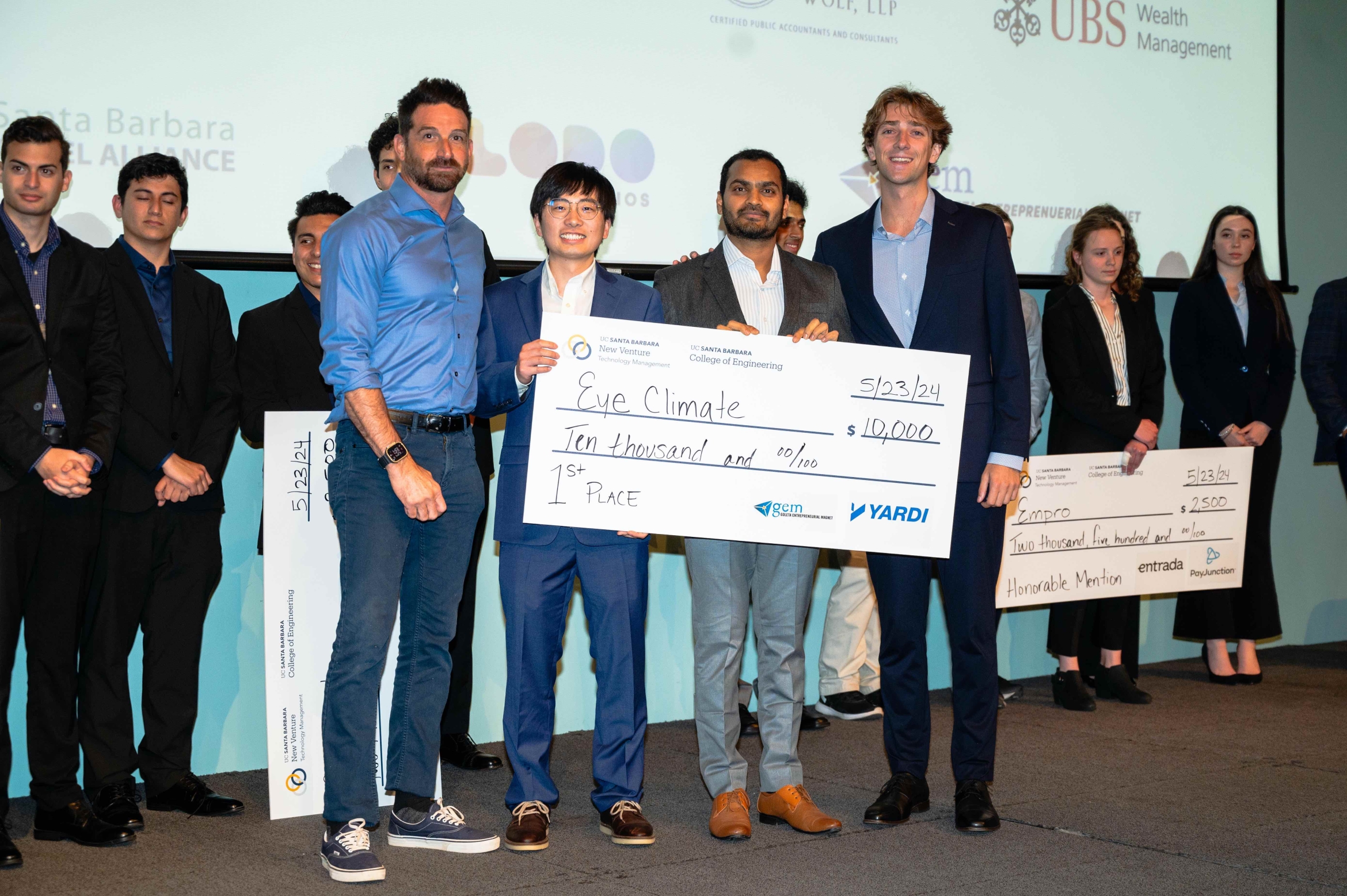
June 3, 2024
An entrepreneurial eye for solving climate change

May 30, 2024
Historic iceberg surges offer insights on modern climate change

May 29, 2024
Shining a light on new chemical reactions
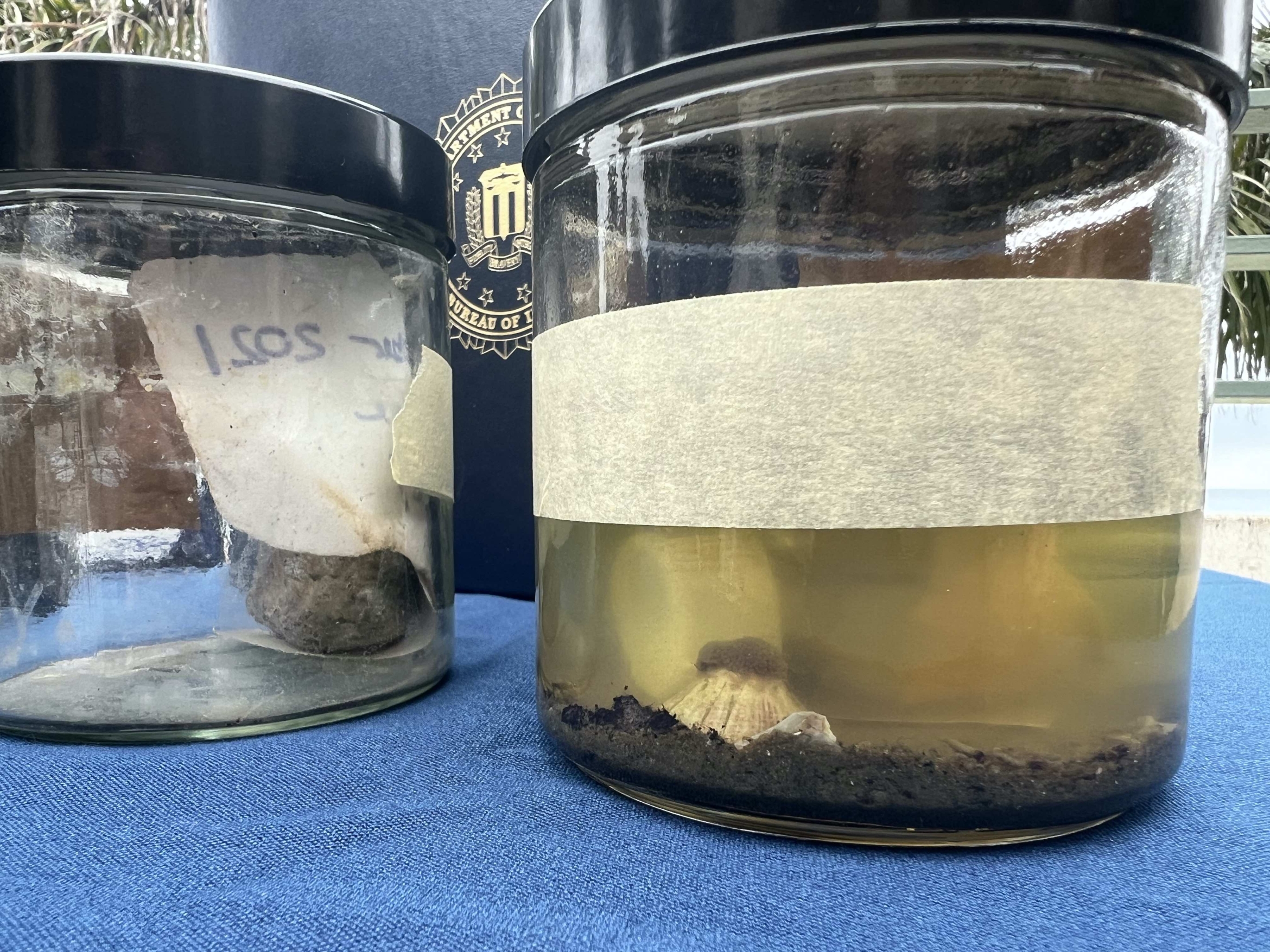
May 23, 2024
How Marine Science Institute researchers helped solve the 2021 Huntington Beach oil spill
Creating a dignified future of work for all
Bringing together thought-leaders from across the continent to discuss the opportunities and challenges presented by generative AI in the future of work in Africa
- Follow on Twitter
- Like on Facebook
- Follow on LinkedIn
- Subscribe on Youtube
- Follow on Instagram
- Subscribe to our RSS feed
Share this page:
- Share on Twitter
- Share on Facebook
- Share on LinkedIn
- Share on Reddit
Hurricane Research Division

Hurricane Research
Dynamics and physics.
Visit the Dynamics & Physics Page
Observing Techniques
Visit the Observing Systems Page
Modeling and Prediction
Visit the Modeling & Prediction Page
Data Assimilation
Visit the Data Assimilation Page
Hurricane Impacts
Visit the Impacts Page
Featured Projects

Saharan Air Layer
Effects on Atlantic Tropical Cyclones

Extratropical Transition
Forecasting Impacts in Midlatitudes
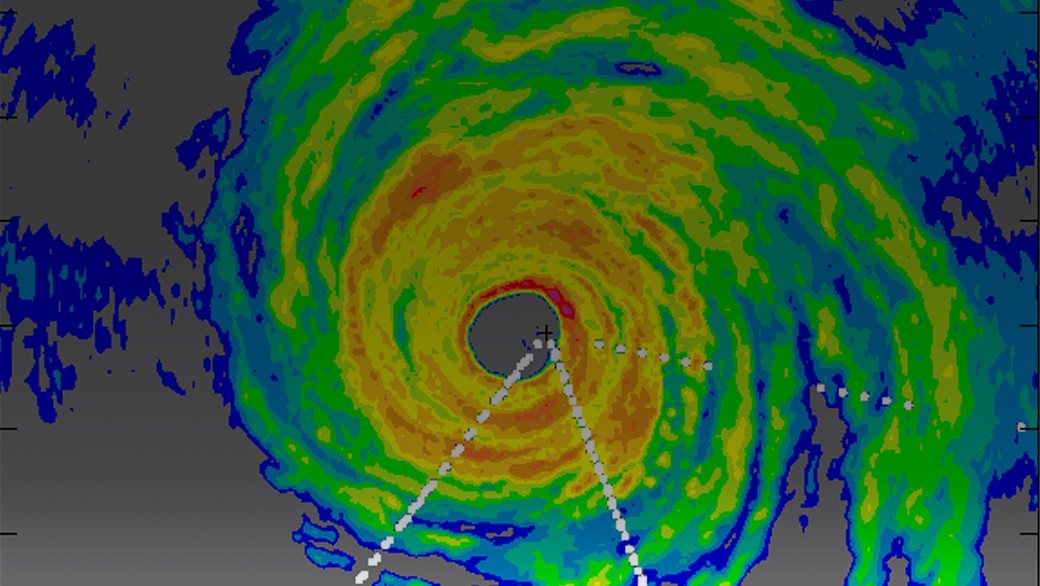
Real-Time Doppler Winds
Analyzing & Delivering Data in “Real-Time”

Observing System Experiments
Using Aircraft Data
Hurricane Field Program
Experiments, flight plans and, operational maps and information for 2024, hurricane data, previous years data by storm.
View previous years' data by storm on our Data Page. Includes wind speed, temperature and humidity profiles, radar and visuals, and more.
Hurricane Model Viewer
Graphical products for experimental NOAA models and operational models.
2023 Field Program Data
All encompassing data suite includes wind speed, temperature and humidity profiles, radar and visuals, and more.
Research Capability & Expertise
Each WP-3D aircraft has three radars: nose, lower fuselage, and tail. The nose radar (a solid-state C-band radar with a 5° circular beam) is used strictly for flight safety and is not recorded for research purposes. The lower fuselage and tail radars are used for operational and research purposes. The G-IV aircraft has a nose and a tail radar too.
Expendables Dropwindsondes are deployed from the aircraft and drift down on a parachute measuring vertical profiles of pressure, temperature, humidity and wind as they fall. They are released from the both the WP-3D and G-IV aircraft over data-sparse oceanic regions. Airborne eXpendable BathyThermographs (AXBT) Airborne eXpendable Current Profilers (AXCP) Airborne eXpendable Conductivity Temperature and Depth probes (AXCTD) Drifting buoys
Oceanographic instruments may be deployed from the WP-3D aircraft either from external chutes using explosive cads or from an internal drop chute. They activate upon hitting the ocean surface and radio sea temperature, salinity, and current information back to computers aboard the aircraft.
Visit Expendables Page
Remote Sensing
Among the suite of airborne remote sensing instruments available on the WP-3D aircraft for the purpose of measuring surface winds in and around tropical cyclones are the Stepped Frequency Microwave Radiometer and the C-band scatterometer (C-SCAT). The C-SCAT conically scans the ocean surfaceobtaining backscatter measurements from 20° to 50° off nadir
C-Band Scatterometer (C-SCAT) The C-SCAT antenna is a microstrip phased array whose main lobe can be pointed at 20°, 30°, 40°, and 50° off nadir. The antenna is rotated in azimuth at 30 rpm. Thus, conical scans of the ocean surface are repeated every 2 s (0.25 km at 125 m/s ground speed).
Data assimilation is a technique by which numerical model data and observations are combined to obtain an analysis that best represents the state of the atmospheric phenomena of interest. At HRD, the focus is on the utilization of a wide range of observations for the state analysis of tropical systems and their near environments to study their structure and physical/dynamical processes, and to improve numerical forecasts. Research includes the development and application of a state-of-the-art ensemble-based data assimilation system (the Hurricane Ensemble Data Assimilation System – HEDAS) with the operational Hurricane Weather Research and Forecast model, using airborne, satellite and other observations. In parallel, Observing System Simulation Experiments are conducted for the systematic evaluation of proposed observational platforms geared toward the better sampling of tropical weather systems.
AOML developed the high-resolution HWRF model, the first 3 km-resolution regional model to be officially adopted and run operationally by the National Hurricane Center at the start of the 2012 hurricane season. This state-of-the-art research involved the following key elements:
High-resolution numerical model developments; Advancements to physical parameterizations for hurricane models based on observations; And above all, advancements in the basic understanding of hurricane processes.
In collaboration with NCEP‘s Environmental Modeling Center, and with the vital support of NOAA‘s Hurricane Forecast Improvement Project (HFIP), we are fully committed for years to come to the development and further advancement of NOAA‘s HWRF modeling system. A basin-sale version of the HWRF model is now in transition to operations. Visit the Hurricane Modeling and Prediction page to learn more.
News & Events

Developments in Hurricane Model Contributed to its Lasting Legacy
April 30, 2024
Improvements in the operational Hurricane Weather Research and Forecasting Model paved the way for tropical cyclone prediction and modeling by lowering intensity forecast errors by 45-50%.
Innovative Flight Patterns Boost Hurricane Forecast Accuracy, NOAA Study Finds
12 Days of AOML Research
AOML awarded for exceptional science and communications accomplishments
NOAA Pioneers New Ways to Advance Hurricane Forecasting
Improvements in Forecasting, Weather, Floods and Hurricanes
Providing research to make forecasts better.
This overview report includes work on the Hurricane Analysis and Forecasting System (HAFS) , a set of moving, high-resolution nests around tropical cyclones in the global weather model, and the AOML Hurricane Model Viewer .
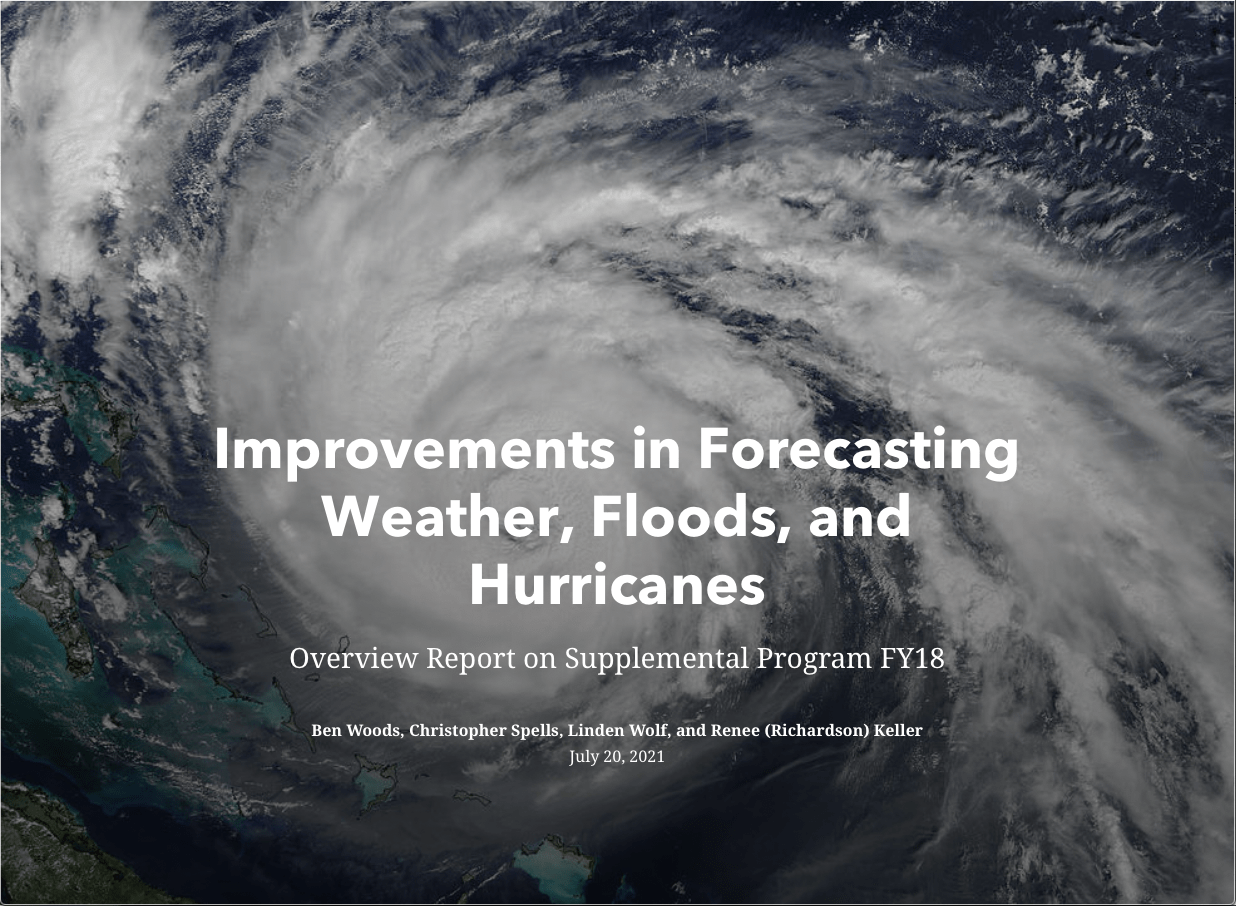
Featured Publication
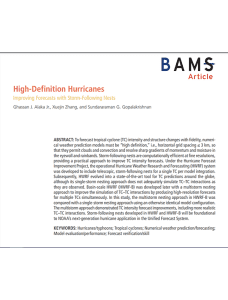
Alaka Jr, G. J., Zhang, X., & Gopalakrishnan, S. G. (2022). High-definition hurricanes: improving forecasts with storm-following nests. Bulletin of the American Meteorological Society , 103 (3), E680-E703.
Abstract: To forecast tropical cyclone (TC) intensity and structure changes with fidelity, numerical weather prediction models must be “high definition,” i.e., horizontal grid spacing ≤ 3 km, so that they permit clouds and convection and resolve sharp gradients of momentum and moisture in the eyewall and rainbands. Storm-following nests are computationally efficient at fine resolutions, providing a practical approach to improve TC intensity forecasts. Under the Hurricane Forecast Improvement Project, the operational Hurricane Weather Research and Forecasting (HWRF) system was developed to include telescopic, storm-following nests for a single TC per model integration.
Download Full Paper
High-Definition Hurricanes: Improving Forecasts with Storm-Following Nests
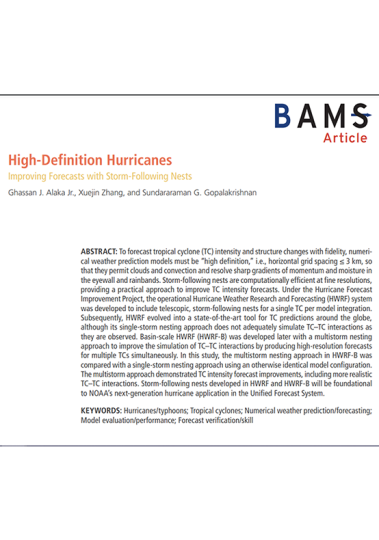
Looking for scientific literature? Visit our Publication Database.
Dropsondes Measure Important Atmospheric Conditions
Airborne radar.
As our Hurricane Hunter Scientists make passes through the storm, they release small sensor packages on parachutes called dropsondes. These instruments provide measurements of temperature, pressure, humidity and wind as they descend through the storm. See more of our videos on YouTube.

Frequently Asked Questions about Hurricanes
Why don't nuclear weapons destroy hurricanes.
Radioactive fallout from such an operation would far outweigh the benefits and may not alter the storm. Additionally, the amount of energy that a storm produces far outweighs the energy produced by one nuclear weapon.
How Much Energy is Released from a Hurricane?
The energy released from a hurricane can be explained in two ways: the total amount of energy released by the condensation of water droplets (latent heat), or the amount of kinetic energy generated to maintain the strong, swirling winds of a hurricane. The vast majority of the latent heat released is used to drive the convection of a storm, but the total energy released from condensation is 200 times the world-wide electrical generating capacity, or 6.0 x 10 14 watts per day. If you measure the total kinetic energy instead, it comes out to about 1.5 x 10 12 watts per day, or ½ of the world-wide electrical generating capacity. It would seem that although wind energy seems the most obvious energetic process, it is actually the latent release of heat that feeds a hurricane’s momentum.
What Causes Tropical Cyclones?
In addition to hurricane-favorable conditions such as temperature and humidity, many repeating atmospheric phenomenon contribute to causing and intensifying tropical cyclones. For example, African Easterly Waves are winds in the lower troposphere (ocean surface to 3 miles above) that travel from Africa at speeds of about 3mph westward as a result of the African Easterly Jet. These winds are seen from April until November. About 85% of intense hurricanes and about 60% of smaller storms have their origin in African Easterly waves.
The Saharan Air Layer is another significant seeding phenomenon for tropical storms. It is a mass of dry, mineral-rich, dusty air that forms over the Sahara from late spring to early fall and moves over the tropical North Atlantic every 3-5 days at speeds of 22-55mph (10-25 meters per second). The air mass is 1-2 miles deep, exists in the lower troposphere, and can be as wide as the continental US. These air masses have significant moderating impacts on tropical cyclone intensity and formation because the dry, intense air can both deprive the storm of moisture and interfere with its convection by increasing the wind shear.
Many tropical cyclones form due to these larger scale atmospheric factors. Hurricanes that form fairly close in our basin are called Cape Verde hurricanes, named for the location where they are formed. Cape Verde origin hurricanes can be up to five per year, with an average of around two.
Why are Tropical Cyclones Always Worse on the Right Side?
If a hurricane is moving to the west, the right side would be to the north of the storm, if it is heading north, then the right side would be to the east of the storm. The movement of a hurricane can be broken into two parts- the spiral movement and its forward movement. If the hurricane is moving forward, the side of the spiral with winds parallel and facing forward in the direction of movement will go faster, because you are adding two velocities together. The side of the spiral parallel to the movement, but going in the opposite direction will be slower, because you must subtract the velocity moving away (backwards) from the forward velocity.
For example, a hurricane with 90mph winds moving at 10mph would have a 100mph wind speed on the right (forward-moving) side and 80 mph on the side with the backward motion.
How are Hurricanes Named?
During the 19th century, hurricane names were inspired by everything from saints to wives to unpopular politicians. In 1978, it was agreed that the National Hurricane Center would use alternating men and women’s names following the practice adopted by Australia’s bureau of Meteorology three years earlier in 1975.
Today, a list of potential names is published by the United Nations World Meteorological Organization for the Atlantic basin. These names extend into 2023, and the list repeats every seventh year. If a particularly damaging storm occurs, the name of that storm is retired. Storms retired in 2017 include Harvey, Irma, Maria, and Nate. If there are more storms than names on the list in a given season, the National Hurricane Center will name them using the Greek alphabet. Lastly, if a storm happens to move across basins, it keeps the original name. The only time it is renamed if it dissipates to a tropical disturbance and reforms.
With Hurricane Hunters Dr. Frank Marks & Commander Justin Kibbey

Shirley Murillo
305.361.4509
| Shirley Murillo
Acting Director, Hurricane Research Division

Aaron Poyer
301.427.9619
| Aaron Poyer
Acting Deputy Director, Hurricane Research Division
Our Field Photos
Scientists and Hurricane Hunters Paul Reasor and Robert Rogers preparing for flight into Hurricane Barry. Photo Credit, NOAA AOML.
The Global Hawk unmanned aircraft can fly continuously for 24 hours in a storm, collecting critical atmospheric data. Photo Credit, NOAA AOML.
Sunrise photo above the clouds from a hurricane hunter aircraft. Photo Credit, NOAA AOML.
Frank Marks Takes a Selfie with Ms. Piggy- The P3 aircraft have nicknames. This one is called Miss Piggy after one of Jim Henson’s The Muppets character. Photo Credit, NOAA AOML.
Photo of the P3 flying science lab on the tarmac ready for its next flight. Photo Credit, NOAA AOML.
Scientist drops scientific instruments into the hurricane below to take measurements that improve our forecasts. Photo Credit, NOAA AOML.
The eye of a hurricane as seen by a P3 aircraft. Photo Credit, NOAA AOML.
Hurricane researchers Paul Reasor (L) and Rob Rogers (R) are hard at work analyzing data during their flight into Tropical Storm Barry. Photo Credit: NOAA.

The Meaning of a Webcam
- by CMSI Intern Elijah Valerjev
- June 04, 2024
Quick Summary
- A crowdfunding campaign to install a new webcam at BMR has revealed the importance of connecting the community to research.
The UC Davis Bodega Marine Reserve (BMR) has a webcam in Horseshoe Cove to capture images of marine life. However, a 2023 survey analyzing users’ experiences with the webcam revealed complications with the camera:
"A constantly clear picture would be nice. Too often the picture is fragmented or just blacked out."
"Sometimes [I] can’t see anything, [and] other times the picture is broken up."
"The cam resolution is low and it does not refresh often."
"The [camera] image is not consistently clear or usable.”
In the same survey, 160 out of 187 respondents shared that they extensively used the webcam for observing oceanic and weather conditions. However, when rating the performance of the camera on a scale of 1 to 10, they gave the old webcam an average of 5.9.
To provide better public access, BMR participated in a Crowdfund UC Davis project to raise funds for a new webcam. The initiative was a success, surpassing its $7,500 goal by raising $11,725 from over 70 donors, which was also the highest-grossing crowdfunding campaign in its cohort of 26 programs.
Suzanne Olyarnik, BMR Director, reports that support for the webcam was widespread. “People were motivated for [a new camera]. People understand the mission of [the reserve’s] educational purposes.”
The Process
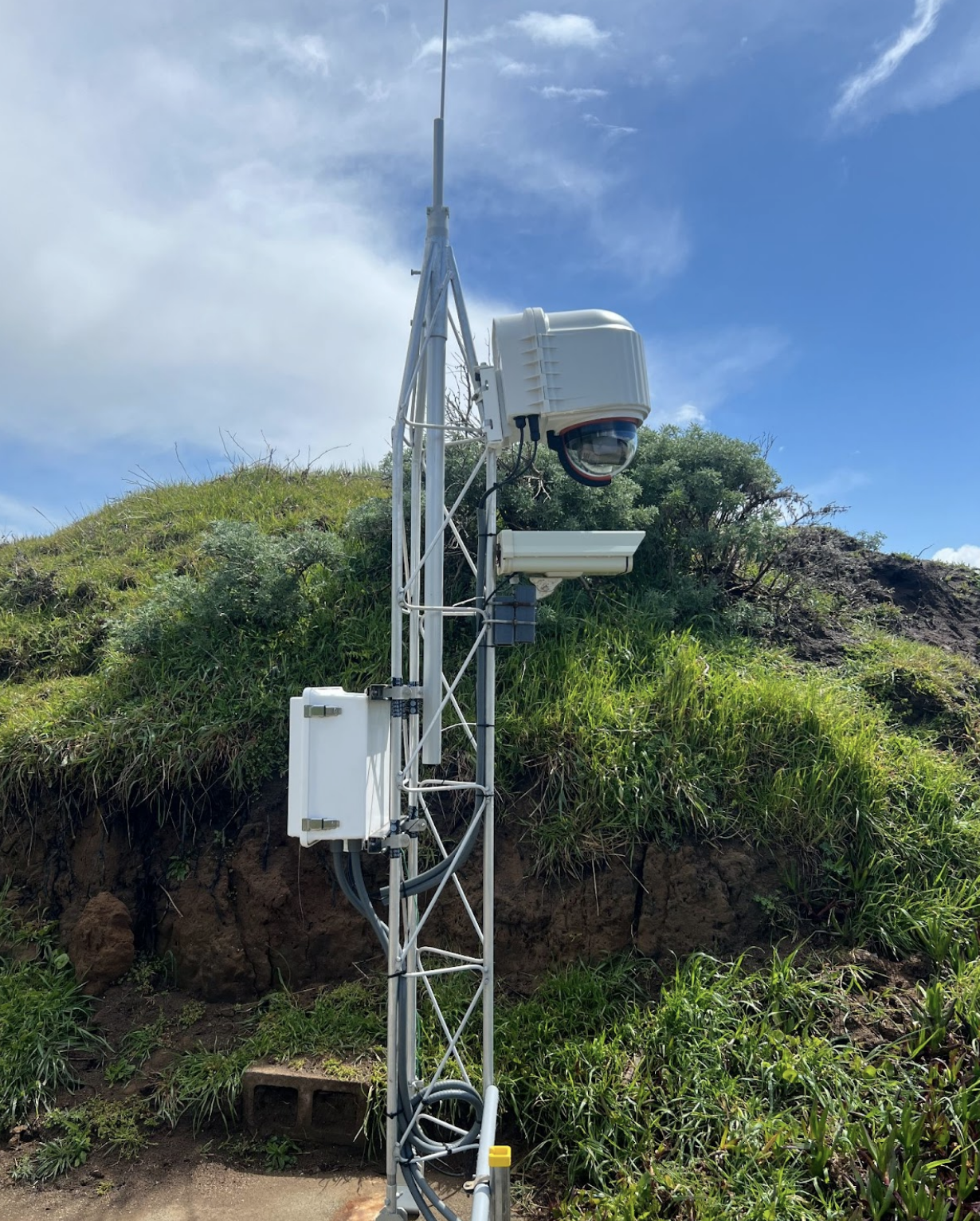
Though the funding was provided as early as November 2023, winter storms delayed installation and threatened the security of the camera’s location. “We've suffered some of the worst waves I've seen in my 20 years [here]. We had one wave come over the entire bluff and bring logs, granite, and debris within five feet of the buildings,” says Phillip Smith, Bodega Marine Laboratory (BML)’s Physical Plant technician, who installed the camera.
Michael “Moose” O’Donnell, Deputy Director of CMSI, also helped replace the old camera. He describes that even normal ocean wave patterns caused trouble for the old camera. “The big problem with the old one was [that it was] behind a plexiglass window 50 feet from the ocean, which meant it was constantly getting salt buildup on the screen.”
The new camera has therefore been reinforced with corrosion-resistant metal spires to block debris from hitting the tower. To avoid blurry vision, the camera comes with a cleaning mechanism to wipe off the camera everyday.
However, the project did not come without additional challenges. The old webcam was connected to failing internet cables, requiring a replacement of dated underground cables that also span almost 300 feet long.
Additionally, the weak internet connection at Bodega cannot stream the live feed to every simultaneous viewer. Consequently, the data had to be offloaded to YouTube, which has also been difficult to work with. Fortunately, the new camera now live streams at 720p, which is a major upgrade from the old camera’s limited ability to only produce an image every 10 minutes.
All of these tasks placed Smith and O’Donnell on a time crunch to get the camera running before seal pupping season starts in early April. During springtime, the reserve closes down the beach to all human activity for the annual birthing of the seal pups so that the animals are both comfortable and protected to take refuge at Horseshoe Cove.
Smith says that the biggest emphasis was getting the camera in on-time to avoid disturbing the seals. “It's a happy achievement. Everyone looking through that camera will be able to watch all these baby seals moving up and down the beach learning how to swim,” Smith reflects.

Casting a Wide Message
Olyarnik indicates the potential of the new webcam. Researchers rely on the camera for various projects, from directly assessing fog input from climate change, to observing the growth dynamics of terrestrial plants. The webcam also documents these metrics , which are useful for the researchers at BML. She clarifies that since human activity must be extremely limited to protect such sensitive projects. “We've been here for almost 60 years. It's important that we have [the reserve] protected for our main mission [to provide] research and education. We need to make sure that the folks doing their research here don't get impacted by recreational activities and unrestricted access.”
Aside from the research, O’Donnell comments that “[the camera] is a super resource. We have a big mission at Bodega to protect the environment and keep it pristine for study. But we also have a job to inform the public about what's going on in the world. This is a neat way to do it.”
Survey Responses:
"I have been going to Bodega Bay for ~52 years. Your webcam is very relaxing and it makes me feel good. Our family has also visited the Marine Lab/Reserve over the years [and] the wildlife is awesome. Thank you."
"This is the only reliable source for Bodega Bay Area weather, wind, and wave conditions. The webcam is vital for updated conditions for people not in the area at the moment.”
"This webcam is a huge help as a key bit of information to help decide if an hour drive to the coast would be worth it for going to the beach. I ALWAYS check this webcam before going."
O’Donnell adds that due to the popularity of the new camera, there are plans to implement an additional camera with the leftover funds, in due time. “We'd like to install another camera at a different location to get a different view of the offshore where we might observe interesting oceanography.”
The new webcam is now in-testing on our YouTube channel and will soon be streaming to our website . In addition to visual access from the new webcam, BML is open every Friday from 2 to 4 pm for public tours with a reservation .
About the Author:
Elijah Valerjev, UC Davis class of 2024, is a Molecular and Medical Microbiology major with an Education and Professional Writing double minor. Interested in science communication, he enjoys the storytelling aspect of science writing, and is especially interested in connecting research topics to societal issues. Elijah works as board editor for the Aggie Transcript Undergraduate Research Journal, in addition to his work for the CMSI. In his spare time, he can be found enjoying his hobbies which include boxing, fiction writing and watching movies.
Primary Category
Numbers, Facts and Trends Shaping Your World
Read our research on:
Full Topic List
Regions & Countries
- Publications
- Our Methods
- Short Reads
- Tools & Resources
Read Our Research On:
Table of Contents
Which social media platforms are most common, who uses each social media platform, find out more, social media fact sheet.
Many Americans use social media to connect with one another, engage with news content, share information and entertain themselves. Explore the patterns and trends shaping the social media landscape.
To better understand Americans’ social media use, Pew Research Center surveyed 5,733 U.S. adults from May 19 to Sept. 5, 2023. Ipsos conducted this National Public Opinion Reference Survey (NPORS) for the Center using address-based sampling and a multimode protocol that included both web and mail. This way nearly all U.S. adults have a chance of selection. The survey is weighted to be representative of the U.S. adult population by gender, race and ethnicity, education and other categories.
Polls from 2000 to 2021 were conducted via phone. For more on this mode shift, read our Q&A.
Here are the questions used for this analysis , along with responses, and its methodology .
A note on terminology: Our May-September 2023 survey was already in the field when Twitter changed its name to “X.” The terms Twitter and X are both used in this report to refer to the same platform.

YouTube and Facebook are the most-widely used online platforms. About half of U.S. adults say they use Instagram, and smaller shares use sites or apps such as TikTok, LinkedIn, Twitter (X) and BeReal.
Note: The vertical line indicates a change in mode. Polls from 2012-2021 were conducted via phone. In 2023, the poll was conducted via web and mail. For more details on this shift, please read our Q&A . Refer to the topline for more information on how question wording varied over the years. Pre-2018 data is not available for YouTube, Snapchat or WhatsApp; pre-2019 data is not available for Reddit; pre-2021 data is not available for TikTok; pre-2023 data is not available for BeReal. Respondents who did not give an answer are not shown.
Source: Surveys of U.S. adults conducted 2012-2023.

Usage of the major online platforms varies by factors such as age, gender and level of formal education.
% of U.S. adults who say they ever use __ by …
- RACE & ETHNICITY
- POLITICAL AFFILIATION

This fact sheet was compiled by Research Assistant Olivia Sidoti , with help from Research Analyst Risa Gelles-Watnick , Research Analyst Michelle Faverio , Digital Producer Sara Atske , Associate Information Graphics Designer Kaitlyn Radde and Temporary Researcher Eugenie Park .
Follow these links for more in-depth analysis of the impact of social media on American life.
- Americans’ Social Media Use Jan. 31, 2024
- Americans’ Use of Mobile Technology and Home Broadband Jan. 31 2024
- Q&A: How and why we’re changing the way we study tech adoption Jan. 31, 2024
Find more reports and blog posts related to internet and technology .
1615 L St. NW, Suite 800 Washington, DC 20036 USA (+1) 202-419-4300 | Main (+1) 202-857-8562 | Fax (+1) 202-419-4372 | Media Inquiries
Research Topics
- Email Newsletters
ABOUT PEW RESEARCH CENTER Pew Research Center is a nonpartisan fact tank that informs the public about the issues, attitudes and trends shaping the world. It conducts public opinion polling, demographic research, media content analysis and other empirical social science research. Pew Research Center does not take policy positions. It is a subsidiary of The Pew Charitable Trusts .
© 2024 Pew Research Center
- USC Libraries
- Research Guides
Organizing Your Social Sciences Research Paper
- 1. Choosing a Research Problem
- Purpose of Guide
- Design Flaws to Avoid
- Independent and Dependent Variables
- Glossary of Research Terms
- Reading Research Effectively
- Narrowing a Topic Idea
- Broadening a Topic Idea
- Extending the Timeliness of a Topic Idea
- Academic Writing Style
- Applying Critical Thinking
- Choosing a Title
- Making an Outline
- Paragraph Development
- Research Process Video Series
- Executive Summary
- The C.A.R.S. Model
- Background Information
- The Research Problem/Question
- Theoretical Framework
- Citation Tracking
- Content Alert Services
- Evaluating Sources
- Primary Sources
- Secondary Sources
- Tiertiary Sources
- Scholarly vs. Popular Publications
- Qualitative Methods
- Quantitative Methods
- Insiderness
- Using Non-Textual Elements
- Limitations of the Study
- Common Grammar Mistakes
- Writing Concisely
- Avoiding Plagiarism
- Footnotes or Endnotes?
- Further Readings
- Generative AI and Writing
- USC Libraries Tutorials and Other Guides
- Bibliography
In the social and behavioral sciences, the subject of analysis is most often framed as a problem that must be researched in order to obtain a greater understanding, formulate a set of solutions or recommended courses of action, and/or develop a better approach to practice. The research problem, therefore, is the main organizing principle guiding the analysis of your research. The problem under investigation establishes an occasion for writing and a focus that governs what you want to say. It represents the core subject matter of scholarly communication and the means by which scholars arrive at other topics of conversation and the discovery of new knowledge and understanding.
Alvesson, Mats and Jörgen Sandberg. Constructing Research Questions: Doing Interesting Research . London: Sage, 2013; Jacobs, Ronald L. “Developing a Dissertation Research Problem: A Guide for Doctoral Students in Human Resource Development and Adult Education.” New Horizons in Adult Education and Human Resource Development 25 (Summer 2013): 103-117; Chapter 1: Research and the Research Problem. Nicholas Walliman . Your Research Project: Designing and Planning Your Work . 3rd edition. Thousand Oaks, CA: Sage Publications, 2011.
Choosing a Research Problem / How to Begin
Do not assume that identifying a research problem to investigate will be a quick and easy task! You should be thinking about it during the beginning of the course. There are generally three ways you are asked to write about a research problem : 1) your professor provides you with a general topic from which you study a particular aspect; 2) your professor provides you with a list of possible topics to study and you choose a topic from that list; or, 3) your professor leaves it up to you to choose a topic and you only have to obtain permission to write about it before beginning your investigation. Here are some strategies for getting started for each scenario.
I. How To Begin: You are given the topic to write about
Step 1 : Identify concepts and terms that make up the topic statement . For example, your professor wants the class to focus on the following research problem: “Is the European Union a credible security actor with the capacity to contribute to confronting global terrorism?" The main concepts in this problem are: European Union, security, global terrorism, credibility [ hint : focus on identifying proper nouns, nouns or noun phrases, and action verbs in the assignment description]. Step 2 : Review related literature to help refine how you will approach examining the topic and finding a way to analyze it . You can begin by doing any or all of the following: reading through background information from materials listed in your course syllabus; searching the USC Libraries Catalog to find a recent book on the topic and, if appropriate, more specialized works about the topic; conducting a preliminary review of the research literature using multidisciplinary databases such as ProQuest or subject-specific databases from the " By Subject Area " drop down menu located above the list of databases.
Choose the advanced search option in the database and enter into each search box the main concept terms you developed in Step 1. Also consider using their synonyms to retrieve additional relevant records. This will help you refine and frame the scope of the research problem. You will likely need to do this several times before you can finalize how to approach writing about the topic. NOTE: Always review the references from your most relevant research results cited by the authors in footnotes, endnotes, or a bibliography to locate related research on your topic. This is a good strategy for identifying important prior research about the topic because titles that are repeatedly cited indicate their significance in laying a foundation for understanding the problem. However, if you’re having trouble at this point locating relevant research literature, ask a librarian for help!
ANOTHER NOTE: If you find an article from a database that's particularly helpful, paste it into Google Scholar , placing the title of the article in quotes. If the article record appears, look for a "cited by" reference followed by a number [e.g., C ited by 37] just below the record. This link indicates how many times other scholars have subsequently cited that article in their own research since it was first published. This is an effective strategy for identifying more current, related research on your topic. Finding additional cited by references from your original list of cited by references helps you navigate through the literature and, by so doing, understand the evolution of thought around a particular research problem. Step 3 : Since social science research papers are generally designed to encourage you to develop your own ideas and arguments, look for sources that can help broaden, modify, or strengthen your initial thoughts and arguments. For example, if you decide to argue that the European Union is inadequately prepared to take on responsibilities for broader global security because of the debt crisis in many EU countries, then focus on identifying sources that support as well as refute this position. From the advanced search option in ProQuest , a sample search would use "European Union" in one search box, "global security" in the second search box, and adding a third search box to include "debt crisis."
There are least four appropriate roles your related literature plays in helping you formulate how to begin your analysis :
- Sources of criticism -- frequently, you'll find yourself reading materials that are relevant to your chosen topic, but you disagree with the author's position. Therefore, one way that you can use a source is to describe the counter-argument, provide evidence from your own review of the literature as to why the prevailing argument is unsatisfactory, and to discuss how your approach is more appropriate based upon your interpretation of the evidence.
- Sources of new ideas -- while a general goal in writing college research papers in the social sciences is to examine a research problem with some basic idea of what position you'd like to take and on what basis you'd like to defend your position, it is certainly acceptable [and often encouraged] to read the literature and extend, modify, and refine your own position in light of the ideas proposed by others. Just make sure that you cite the sources !
- Sources for historical context -- another role your related literature plays in formulating how to begin your analysis is to place issues and events in proper historical context. This can help to demonstrate familiarity with developments in relevant scholarship about your topic, provide a means of comparing historical versus contemporary issues and events, and identifying key people, places, and events that had an important role related to the research problem. Given its archival journal coverage, a good multidisciplnary database to use in this case is JSTOR .
- Sources of interdisciplinary insight -- an advantage of using databases like ProQuest to begin exploring your topic is that it covers publications from a variety of different disciplines. Another way to formulate how to study the topic is to look at it from different disciplinary perspectives. If the topic concerns immigration reform, for example, ask yourself, how do studies from sociological journals found by searching ProQuest vary in their analysis from those in political science journals. A goal in reviewing related literature is to provide a means of approaching a topic from multiple perspectives rather than the perspective offered from just one discipline.
NOTE: Remember to keep careful notes at every stage or utilize a citation management system like EndNotes or RefWorks . You may think you'll remember what you have searched and where you found things, but it’s easy to forget or get confused. Most databases have a search history feature that allows you to go back and see what searches you conducted previously as long as you haven't closed your session. If you start over, that history could be deleted.
Step 4 : Assuming you have done an effective job of synthesizing and thinking about the results of your initial search for related literature, you're ready to prepare a detailed outline for your paper that lays the foundation for a more in-depth and focused review of relevant research literature [after consulting with a librarian, if needed!]. How will you know you haven't done an effective job of synthesizing and thinking about the results of our initial search for related literature? A good indication is that you start composing the outline and gaps appear in how you want to approach the study. This indicates the need to gather further background information and analysis about the research problem.
II. How To Begin: You are provided a list of possible topics to choose from Step 1 : I know what you’re thinking--which topic on this list will be the easiest to find the most information on? An effective instructor would never include a topic that is so obscure or complex that no research is available to examine and from which to design an effective study. Therefore, don't approach a list of possible topics to study from the perspective of trying to identify the path of least resistance; choose a topic that you find interesting in some way, that is controversial and that you have a strong opinion about, that has some personal meaning for you, or relates to your major or a minor. You're going to be working on the topic for quite some time, so choose one that you find interesting and engaging or that motivates you to take a position. Embrace the opportunity to learn something new! Once you’ve settled on a topic of interest from the list provided by your professor, follow Steps 1 - 4 listed above to further develop it into a research paper.
NOTE: It’s ok to review related literature to help refine how you will approach analyzing a topic, and then discover that the topic isn’t all that interesting to you. In that case, choose a different topic from the list. Just don’t wait too long to make a switch and, of course, be sure to inform your professor that you are changing your topic.
III. How To Begin: Your professor leaves it up to you to choose a topic
Step 1 : Under this scenario, the key process is turning an idea or general thought into a topic that can be configured into a research problem. When given an assignment where you choose the topic, don't begin by thinking about what to write about, but rather, ask yourself the question, "What do I want to understand or learn about?" Treat an open-ended research assignment as an opportunity to gain new knowledge about something that's important or exciting to you in the context of the overall subject of the course.
Step 2 : If you lack ideas, or wish to gain focus, try any or all of the following strategies:
- Review your course readings, particularly the suggested readings, for topic ideas. Don't just review what you've already read, but jump ahead in the syllabus to readings that have not been covered yet.
- Search the USC Libraries Catalog for a recently published book and, if appropriate, more specialized works related to the discipline area of the course [e.g., for the course SOCI 335: Society and Population, search for books on "population and society" or "population and social impact"]. Reviewing the contents of a book about your area of interest can give you insight into what conversations scholars are having about the topic and, thus, how you might want to contribute your own ideas to these conversations through the research paper you write for the class.
- Browse through some current scholarly [a.k.a., academic, peer reviewed] journals in your subject discipline. Even if most of the articles are not relevant, you can skim through the contents quickly. You only need one to be the spark that begins the process of wanting to learn more about a topic. Consult with a librarian and/or your professor about what constitutes the core journals within the subject area of the writing assignment.
- Think about essays you have written for other courses you have taken or academic lectures and programs you have attended outside of class. Thinking back, ask yourself why did you want to take this class or attend this event? What interested you the most? What would you like to know more about? Place this question in the context of the current course assignment. Note that this strategy also applies to anything you've watched on TV or has been shared on social media.
- Search online news media sources, such as CNN , the Los Angeles Times , Huffington Post , MSNBC , Fox News , or Newsweek , to see if your idea has been covered by the media. Use this coverage to refine your idea into something that you'd like to investigate further, but in a more deliberate, scholarly way in relation to a particular problem that needs to be researched.
Step 3 : To build upon your initial idea, use the suggestions under this tab to help narrow , broaden , or increase the timeliness of your idea so you can write it out as a research problem.
Once you are comfortable with having turned your idea into a research problem, follow Steps 1 - 4 listed in Part I above to further develop it into an outline for a research paper.
Alderman, Jim. "Choosing a Research Topic." Beginning Library and Information Systems Strategies. Paper 17. Jacksonville, FL: University of North Florida Digital Commons, 2014; Alvesson, Mats and Jörgen Sandberg. Constructing Research Questions: Doing Interesting Research . London: Sage, 2013; Chapter 2: Choosing a Research Topic. Adrian R. Eley. Becoming a Successful Early Career Researcher . New York: Routledge, 2012; Answering the Question. Academic Skills Centre. University of Canberra; Brainstorming. Department of English Writing Guide. George Mason University; Brainstorming. The Writing Center. University of North Carolina; Chapter 1: Research and the Research Problem. Nicholas Walliman . Your Research Project: Designing and Planning Your Work . 3rd edition. Thousand Oaks, CA: Sage Publications, 2011; Choosing a Topic. The Writing Lab and The OWL. Purdue University; Mullaney, Thomas S. and Christopher Rea. Where Research Begins: Choosing a Research Project That Matters to You (and the World) . Chicago, IL: University of Chicago Press, 2022; Coming Up With Your Topic. Institute for Writing Rhetoric. Dartmouth College; How To Write a Thesis Statement. Writing Tutorial Services, Center for Innovative Teaching and Learning. Indiana University; Identify Your Question. Start Your Research. University Library, University of California, Santa Cruz; The Process of Writing a Research Paper. Department of History. Trent University; Trochim, William M.K. Problem Formulation. Research Methods Knowledge Base. 2006.
Resources for Identifying a Topic
Resources for Identifying a Research Problem
If you are having difficulty identifying a topic to study or need basic background information, the following web resources and databases can be useful:
- CQ Researcher -- a collection of single-themed public policy reports that provide an overview of an issue. Each report includes background information, an assessment of the current policy situation, statistical tables and maps, pro/con statements from representatives of opposing positions, and a bibliography of key sources.
- New York Times Topics -- each topic page collects news articles, reference and archival information, photos, graphics, audio and video files. Content is available without charge on articles going back to 1981.
- Opposing Viewpoints In Context -- an online resource covering a wide range of social issues from a variety of perspectives. The database contains a media-rich collection of materials, including pro/con viewpoint essays, topic overviews, primary source materials, biographies of social activists and reformers, journal articles, statistical tables, charts and graphs, images, videos, and podcasts.
- Policy Commons -- platform for objective, fact-based research from the world’s leading policy experts, nonpartisan think tanks, and intergovernmental and non-governmental organizations. The database provides advanced searching across millions of pages of books, articles, working papers, reports, policy briefs, data sets, tables, charts, media, case studies, and statistical publications, including archived reports from more than 200 defunct think tanks. Coverage is international in scope.
Descriptions of resources are adapted or quoted from vendor websites.
Writing Tip
Not Finding Anything on Your Topic? Ask a Librarian!
Don't assume or jump to the conclusion that your topic is too narrowly defined or obscure just because your initial search has failed to identify relevant research. Librarians are experts in locating and critically assessing information and how it is organized. This knowledge will help you develop strategies for analyzing existing knowledge in new ways. Therefore, always consult with a librarian before you consider giving up on finding information about the topic you want to investigate. If there isn't a lot of information about your topic, a librarian can help you identify a closely related topic that you can study. Use the Ask-A-Librarian link above to identify a librarian in your subject area.
Another Writing Tip
Don't be a Martyr!
In thinking about what to study, don't adopt the mindset of pursuing an esoteric or overly complicated topic just to impress your professor but that, in reality, does not have any real interest to you. Choose a topic that is challenging but that has at least some interest to you or that you care about. Obviously, this is easier for courses within your major, but even for those nasty prerequisite classes that you must take in order to graduate [and that provide an additional tuition revenue for the university], try to apply issues associated with your major to the general topic given to you. For example, if you are an international relations major taking a GE philosophy class where the assignment asks you to apply the question of "what is truth" to some aspect of life, you could choose to study how government leaders attempt to shape truth through the use of nationalistic propaganda.
Still Another Writing Tip
A Research Problem is Not a Thesis Statement
A thesis statement and a research problem are two different parts of the introduction section of your paper. The thesis statement succinctly describes in one or two sentences, usually in the last paragraph of the introduction, what position you have reached about a topic. It includes an assertion that requires evidence and support along with your opinion or argument about what you are researching. There are three general types of thesis statements: analytical statements that break down and evaluate the topic; argumentative statements that make a claim about the topic and defend that claim; and, expository statements that present facts and research about the topic. Each are intended to set forth a claim that you will seek to validate through the research you describe in your paper.
Before the thesis statement, your introduction must include a description of a problem that describes either a key area of concern, a condition to be improved upon, a difficulty to be eliminated, or a troubling issue that exists . The research problem describes something that can be empirically verified and measured; it is often followed by a set of questions that underpin how you plan to approach investigating that problem. In short, the thesis statement states your opinion or argument about the research problem and summarizes how you plan to address it.
Tips and Examples for Writing Thesis Statements. The Writing Lab and The OWL. Purdue University; Write a Strong Thesis Statement! The Writing Center, University of Evansville; Thesis Statements. The Writing Center. University of North Carolina; Tutorial #26: Thesis Statements and Topic Sentences. Writing Center, College of San Mateo; Creswell, John W. and J. David Creswell. Research Design: Qualitative, Quantitative, and Mixed Methods Approaches . 5th edition. Thousand Oaks, CA: SAGE Publications, 2017.
- << Previous: Glossary of Research Terms
- Next: Reading Research Effectively >>
- Last Updated: May 30, 2024 9:38 AM
- URL: https://libguides.usc.edu/writingguide

IMAGES
VIDEO
COMMENTS
Research Project. Definition: Research Project is a planned and systematic investigation into a specific area of interest or problem, with the goal of generating new knowledge, insights, or solutions. It typically involves identifying a research question or hypothesis, designing a study to test it, collecting and analyzing data, and drawing ...
The Research Assignment Introduction. When tasked with writing a research paper, you are able to "dig in" to a topic, idea, theme, or question in greater detail. In your academic career, you will be assigned several assignments that require you to "research" something and then write about it. Sometimes you can choose a topic and ...
Understanding Research Assignments. Before you begin researching and writing, you should spend some time understanding your assignment and preparing your process and workflows. To make the most productive use of your time, you'll need to know what you're trying to accomplish and have a consistent process for gathering information, reading, and ...
Random assignment is an important part of control in experimental research, because it helps strengthen the internal validity of an experiment and avoid biases. In experiments, researchers manipulate an independent variable to assess its effect on a dependent variable, while controlling for other variables.
A research paper is a piece of academic writing that provides analysis, interpretation, and argument based on in-depth independent research. Research papers are similar to academic essays, but they are usually longer and more detailed assignments, designed to assess not only your writing skills but also your skills in scholarly research ...
Failure to delimit the contextual scope of your research [e.g., time, place, people, etc.]. As with any research paper, your proposed study must inform the reader how and in what ways the study will frame the problem. Failure to develop a coherent and persuasive argument for the proposed research. This is critical.
A research design is a strategy for answering your research question using empirical data. Creating a research design means making decisions about: Your overall research objectives and approach. Whether you'll rely on primary research or secondary research. Your sampling methods or criteria for selecting subjects. Your data collection methods.
Random assignment is used in experiments with a between-groups or independent measures design. In these research designs, researchers will manipulate an independent variable to assess its effect on a dependent variable, while controlling for other variables. There is usually a control group and one or more experimental groups.
A well-planned research design helps ensure that your methods match your research aims and that you use the right kind of analysis for your data. You might have to write up a research design as a standalone assignment, or it might be part of a larger research proposal or other project. In either case, you should carefully consider which methods ...
Definition and Purpose. Descriptive research designs help provide answers to the questions of who, what, when, where, and how associated with a particular research problem; a descriptive study cannot conclusively ascertain answers to why. ... but a self-contained research project that explores a clearly defined research problem using existing ...
The introduction leads the reader from a general subject area to a particular topic of inquiry. It establishes the scope, context, and significance of the research being conducted by summarizing current understanding and background information about the topic, stating the purpose of the work in the form of the research problem supported by a hypothesis or a set of questions, explaining briefly ...
The research topic is too broad (or just poorly articulated). The research aims, objectives and questions don't align. The research topic is not well justified. The study has a weak theoretical foundation. The research design is not well articulated well enough. Poor writing and sloppy presentation. Poor project planning and risk management.
Research design refers to the overall plan, structure or strategy that guides a research project, from its conception to the final analysis of data. Research designs for quantitative studies include descriptive, correlational, experimental and quasi-experimenta l designs. Research designs for qualitative studies include phenomenological ...
An assignment can look pretty straightforward at first, particularly if the instructor has provided lots of information. That does not mean it will not take time and effort to complete; you may even have to learn a new skill to complete the assignment. Ask the instructor about anything you do not understand.
This article takes you through the first steps of the research process, helping you narrow down your ideas and build up a strong foundation for your research project. Table of contents. Step 1: Choose your topic. Step 2: Identify a problem. Step 3: Formulate research questions. Step 4: Create a research design. Step 5: Write a research proposal.
These changes include updates to the peer review and submission of most research project grants, fellowships, and training grants; Common Forms for NIH biographical sketch and Current and Pending (Other) Support; updated instructions for reference letters; and the transition to FORMS-I application instructions.
In April 2023, as part of a government-wide collaboration that includes 12 federal agencies and offices, NIH released a Request for Information on Food is Medicine Research Opportunities to gather input on the following topic areas: 1) Research, 2) Community Outreach and Engagement, 3) Education and Training, 4) Provision of Food is Medicine ...
Project charter: This is a definitive document that describes the project and main details necessary to reach its goals. This can include potential risks, benefits, constraints, and key stakeholders. ... Learners are advised to conduct additional research to ensure that courses and other credentials pursued meet their personal, professional ...
The International Joint Initiative for Research in Climate Change Adaptation and Mitigation required that projects address at least two of the eight representative key risks identified in the Sixth Assessment Report of the United Nations' Intergovernmental Panel on Climate Change.The report highlights the unprecedented changes in Earth's climate that are being observed in every region ...
The project, which spans 11 institutions, has received $9.5 million from the nonprofit Schmidt Sciences to fund research over the next five years. It is one of five selected by Schmidt Science and the Schmidt Ocean Institute to join the philanthropy's Ocean Biogeochemistry Virtual Institute (OBVI).
A case study is a research method that involves an in-depth analysis of a real-life phenomenon or situation. Learn how to write a case study for your social sciences research assignments with this helpful guide from USC Library. Find out how to define the case, select the data sources, analyze the evidence, and report the results.
Microsoft Research Africa, Nairobi Creating a dignified future of work for all. Bringing together thought-leaders from across the continent to discuss the opportunities and challenges presented by generative AI in the future of work in Africa . Overview Keynote speakers People ...
12-12:30 pm -- Lunch, Welcome Remarks, and Presentation on "A Decade of CESTA Data" 12:30-3:30 pm -- DH Research Fellows' Showcase 12:30 - 1:50 PM : The Meaning and Measurement of Place with presentations from: Matt Randolph (PhD Candidate in History): "Bringing AI to Archibald Grimké's Archive: A Case Study of Artificial Intelligence for Histories of Race and Slavery" This digital project ...
AOML's hurricane research division has been in operation longer than AOML itself, and is developing next generation hurricane modelling. ... and with the vital support of NOAA's Hurricane Forecast Improvement Project (HFIP), we are fully committed for years to come to the development and further advancement of NOAA's HWRF modeling system ...
Research questions give your project a clear focus. They should be specific and feasible, but complex enough to merit a detailed answer. 2613. How to Write a Literature Review | Guide, Examples, & Templates A literature review is a survey of scholarly knowledge on a topic. Our guide with examples, video, and templates can help you write yours.
To provide better public access, BMR participated in a Crowdfund UC Davis project to raise funds for a new webcam in Horseshoe Cove. The initiative was a success, surpassing its $7,500 goal by raising $11,725 from over 70 donors, which was also the highest-grossing crowdfunding campaign in its cohort of 26 programs.
To better understand Americans' social media use, Pew Research Center surveyed 5,733 U.S. adults from May 19 to Sept. 5, 2023. Ipsos conducted this National Public Opinion Reference Survey (NPORS) for the Center using address-based sampling and a multimode protocol that included both web and mail. This way nearly all U.S. adults have a chance ...
This is a point file of mean fish diversity within 5 minute grid cells. The Shannon Index of diversity was calculated from Southern California Coastal Water Research Project (SCCWRP) fish trawl data. Data from 425 fishery independent trawls ranging from 2-215 meters depth were collected in 1994 and 1998 during the months of June-August.
Definition. In the social and behavioral sciences, the subject of analysis is most often framed as a problem that must be researched in order to obtain a greater understanding, formulate a set of solutions or recommended courses of action, and/or develop a better approach to practice. ... Your Research Project: Designing and Planning Your Work ...